国际商务复习题
国际商务信函复习资料_普通用卷

国际商务信函课程一单选题 (共32题,总分值32分 )1. please insure() invoice value plus 10%. (1 分)A. forB. withC. atD. against2. This container can be easily opened ()both ends. (1 分)A. byB. onC. atD. in3. Your letter of May 9th addressed to our Nanjing Branch Office has ()to us for attention and reply. (1 分)A. been passed onB. passedC. passed onD. been past through4. As requested ()your letter of October 25,we are sending you herewith the required B/L triplicate4 (1 分)A. by ofB. in inC. for inD. from of5. ()our long business relations and our amicable cooperation prospects, we suggest that you accept our terms. (1 分)A. in thatB. In view ofC. for whichD. because of6. We understand that you will treat this information as()(1 分)A. confidenceB. confidentC. confidentialD. confidently7. If you can supply your goods immediately, we shall()to place a prompt trial order. (1 分)A. be preparedB. be preparingC. prepareD. preparing8. We give you on the attached full details ()packing and working. (1 分)A. regardingB. be regardedC. regardedD. regard.9. Please insure()Leakage (Breakage, Fresh Water Damages) (1 分)A. onB. atC. withD. against10. We () of this opportunity to approach you for the establishment of trade relations with you. (1 分)A. takeB. availC. avail ourselvesD. take ourselves11. We regret that we have suffered heavy loss () your improper packing. (1 分)A. resulted fromB. resulting fromC. resulted inD. resulting in12. ()your inquiry of March 3 for a supply of Forever bicycles ,we are pleased to quote as follows (1 分)A. Replying toB. Replied toC. Replying onD. Relied on13. Good will be shipped ()30 days after receipt of the L/C (1 分)A. toB. onC. forD. within14. This price will remain() for ten days from the date of the letter. (1 分)A. ValuableB. validC. invaluableD. good15. will you please ()to take out All Risks insurance for us on the following consignment? (1 分)A. helpB. arrangeC. coverD. insure16. we have sent you samples by airmail()your instruction (1 分)A. toB. afterC. as perD. for17. We should be pleased to send you a sample()our own expense (1 分)A. atB. inC. againstD. of18. We are offering you goods ()the very high quality. (1 分)A. ofB. atC. forD. with19. We specialize ()all kinds of metals and are always ready to buy in large quantities. (1 分)A. inB. fromC. onD. at20. We are not in a position to offer firm ,as the goods are()(1 分)A. without stockB. outside in stockC. out of stockD. no stock21. ()any change in the date of delivery, please let us know in advance. (1 分)A. There should beB. Should there beC. There would beD. Would there be22. We will refund the premium ()you () receipt of your debit note. (1 分)A. to, uponB. with, uponC. to, atD. with , at23. ()will be added to invoice amount together with freight charges. (1 分)A. coverageB. insuranceC. premiumD. rate24. We will see to()that the L/C is opened within the stipulated time (1 分)A. itB. makeC. letD. attractive25. Damage() the goods was caused by heavy rain in transit. (1 分)A. ofB. toC. forD. on26. Documentary collection is to be made with the documents to be ()to the draft. (1 分)A. enclosedB. attachedC. togetherD. along with27. We certainly accept your offer()you will ship the goods during June. (1 分)A. exceptB. providedC. unlessD. but28. It will be appreciated if you could ()the L/C for another 15 days (1 分)A. expressB. developC. extendD. extension29. please see to () that L/C is opened by cable whenever order is placed with us (1 分)A. themB. itC. the matterD. your way clear30. Pens are packed 12 pieces () a box and 200 boxes a wooden case. (1 分)A. to, inB. in, toC. to, toD. to, of31. We are sending you the samples ()requested. (1 分)A. beB. areC. asD. for32. Our terms of payment()been stipulated in the relative sales contract. (1 分)A. havingB. hasC. haveD. had二翻译题 (共2题,总分值2分 )33. 1. 你方市场另一位供货商以低于类似产品3%的价格向我们报盘。
国际商务习题大全
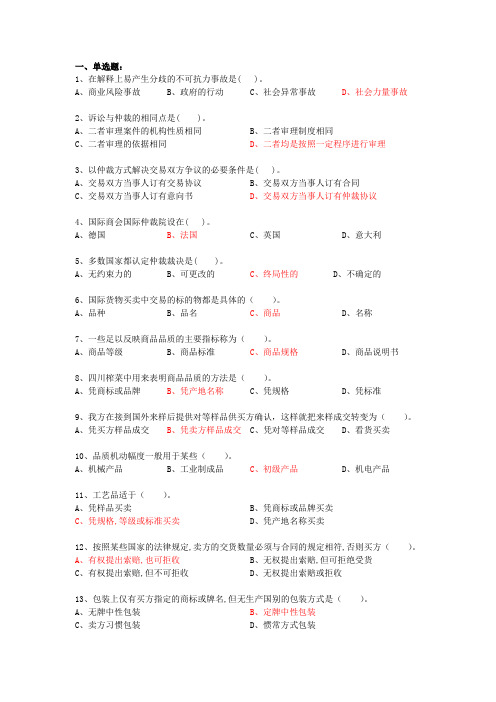
一、单选题:1、在解释上易产生分歧的不可抗力事故是( )。
A、商业风险事故B、政府的行动C、社会异常事故D、社会力量事故2、诉讼与仲裁的相同点是( )。
A、二者审理案件的机构性质相同B、二者审理制度相同C、二者审理的依据相同D、二者均是按照一定程序进行审理3、以仲裁方式解决交易双方争议的必要条件是( )。
A、交易双方当事人订有交易协议B、交易双方当事人订有合同C、交易双方当事人订有意向书D、交易双方当事人订有仲裁协议4、国际商会国际仲裁院设在( )。
A、德国B、法国C、英国D、意大利5、多数国家都认定仲裁裁决是( )。
A、无约束力的B、可更改的C、终局性的D、不确定的6、国际货物买卖中交易的标的物都是具体的()。
A、品种B、品名C、商品D、名称7、一些足以反映商品品质的主要指标称为()。
A、商品等级B、商品标准C、商品规格D、商品说明书8、四川榨菜中用来表明商品品质的方法是()。
A、凭商标或品牌B、凭产地名称C、凭规格D、凭标准9、我方在接到国外来样后提供对等样品供买方确认,这样就把来样成交转变为()。
A、凭买方样品成交B、凭卖方样品成交C、凭对等样品成交D、看货买卖10、品质机动幅度一般用于某些()。
A、机械产品B、工业制成品C、初级产品D、机电产品11、工艺品适于()。
A、凭样品买卖B、凭商标或品牌买卖C、凭规格,等级或标准买卖D、凭产地名称买卖12、按照某些国家的法律规定,卖方的交货数量必须与合同的规定相符,否则买方()。
A、有权提出索赔,也可拒收B、无权提出索赔,但可拒绝受货C、有权提出索赔,但不可拒收D、无权提出索赔或拒收13、包装上仅有买方指定的商标或牌名,但无生产国别的包装方式是()。
A、无牌中性包装B、定牌中性包装C、卖方习惯包装D、惯常方式包装14、在国际货物买卖中,作为卖方,其最基本的义务是()。
A、保证货物的质量B、提交货物和单据C、保证货物的数量D、保证货物的规格15、仅适用于水上运输方式的C组中的贸易术语是()。
国际商务习题
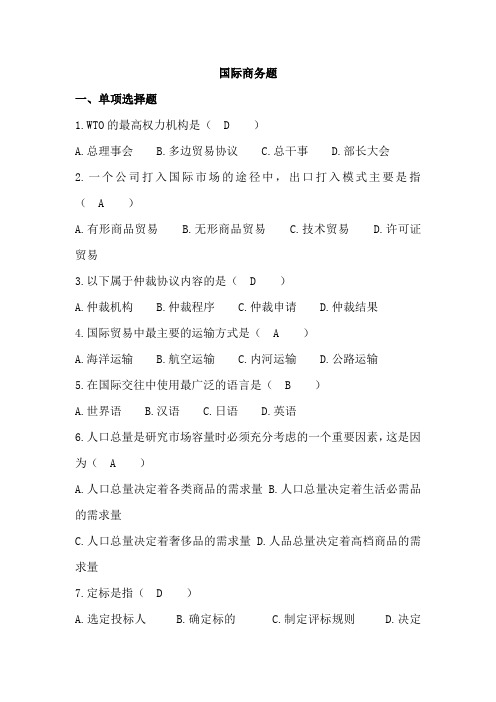
国际商务题一、单项选择题1.WTO的最高权力机构是( D )A.总理事会B.多边贸易协议C.总干事D.部长大会2.一个公司打入国际市场的途径中,出口打入模式主要是指( A )A.有形商品贸易B.无形商品贸易C.技术贸易D.许可证贸易3.以下属于仲裁协议内容的是( D )A.仲裁机构B.仲裁程序C.仲裁申请D.仲裁结果4.国际贸易中最主要的运输方式是( A )A.海洋运输B.航空运输C.内河运输D.公路运输5.在国际交往中使用最广泛的语言是( B )A.世界语B.汉语C.日语D.英语6.人口总量是研究市场容量时必须充分考虑的一个重要因素,这是因为( A )A.人口总量决定着各类商品的需求量B.人口总量决定着生活必需品的需求量C.人口总量决定着奢侈品的需求量D.人品总量决定着高档商品的需求量7.定标是指( D )A.选定投标人B.确定标的C.制定评标规则D.决定中标人8.根据《中国东盟全面经济合作框架协议》,中国与东盟建成自由贸易区的时间是( D )A.2006年B.2008年C.2009年D.2010年9.外汇风险是指由于不确定的汇率波动造成的( A )A.企业资产价值的变化B.企业负债价值的变化C.企业利润的变化D.企业资产或负债价值的变化10.北美自由贸易区的核心是( A )A.美国B.加拿大C.墨西哥D.阿根廷11.第二次世界大战以后,国际分工发展的主要趋势是( C )A.部门间分工B.部门内分工C.产品内分工D.不确定12.企业把目标集中在一个或少数几个子市场的战略,被称为( C )A.产品差异化战略B.成本集中战略C.集中战略D.市场竞争战略13.国际商务最基本的形式是( B )A.国际投资B.国际贸易C.国际经济技术合作D.特许经营14.在其他国家境内的本国律师事务所、银行分支机构提供的服务属于服务贸易中的( C )A.越境提供B.境外消费C.商业存在D.自然人移动15.在纯粹的市场经济体制下,社会生产活动的数量和种类是由( D )A.价格体系的变化决定的B.消费者决定的C.厂商决定的D.供求关系决定的16.下列国家中不属于北美自由贸易区成员的是( C )A.美国B.加拿大C.巴西D.墨西哥17.由于教育的差异,会导致( D )A.对不同消费品的偏好相同B.对同一消费品的偏好相同C.对相同的产品的接受程度相同D.对相同的产品的接受程度不同18.在过去50年时间里,对国际商务活动影响最大的技术进步发生在( C )A.生物和医学领域B.电子和制造领域C.运输和通信领域D.化学和电子领域19.合同磋商的两个基本环节是( C )A.发盘、发价B.要约、反要约C.要约、承诺D.接受、签合同20.仲裁机构属于( A )A.民间组织B.官方组织C.半民间组织D.半官方组织21.在合同的数量条款中明确规定交货数量的增减幅度的条款称为( A )A.溢短装条款B.包装条款C.支付条款D.运输条款22.关于CIF与DES的区别,除了交货地点和交货方式不同外,表述最准确的是( A )A.只有风险划分的界限不同B.只有运输方式不同C.风险划分与费用负担都不同D.只有费用的负担不同23.下列运输方式中,有力地促进了国际多式联运发展的运输方式是( D )A.管道运输B.航空运输C.大陆桥运输D.集装箱运输24.在D/P远期、D/P即期和D/A三种支付方式下,就卖方风险而言,按由大到小顺序排列应为( D )A.D/P远期>D/P即期>D/AB.D/A>D/P即期>D/P远期C.D/P远期>D/A>D/P即期D.D/A>D/P远期>D/P即期25.行审单议付的依据是( C )A.合同、信用证B.合同、单据C.单据、信用证D.信用证、委托书26.CIF合同的货物在装船后因火灾被焚,应由( D )A.卖方负担损失B.卖方请求保险公司赔偿C.买方请求保险公司赔偿D.买方负担损失并请求保险公司赔偿27.包销方式中包销人与供货人之间的关系为( B )A.代理关系B.买卖关系C.委托关系D.互购关系28.被许可方在规定地域和有效期内对转让的技术具有独占使用权,许可方不能再将这项技术转让给第三方,同时许可方自己也不能在该地域内利用这项技术制造和销售产品,这种协议称做( A )A.独占许可协议 B.排它许可协议C.普通许可协议D.可转让许可协议29.提单的种类不包括( D )A.清洁与不清洁提单B.联运提单与联合运输提单C.直达提单与转船提单D.所有权提单与非所有权提单30.某种商品FOB价为69元,运费为20元,保险费率为10%,保险额为CIF价格的110%,则CIF价为( A )A.97.9B.100C.197.9D.8931.根据国际市场需求的特点对现有产品进行修改,以全部或部分解决原有产品不适应国外顾客需求的缺陷,这种产品开发策略称为( A )A.产品延伸B.产品创新C.产品适应D.国际产品32.在交易的成交期和结算期之间由于汇率变化造成的损益称为( C )A.会计风险B.经营风险C.交易风险D.价格风险33.麦当劳快餐店采取的主要经营方式是( D )A.技术咨询服务B.交钥匙工程承包C.合作生产与合作研究D.国际特许经营34.世界汇率制度主要包括( B )A.固定汇率制、钉住汇率制B.固定汇率制、浮动汇率制C.浮动汇率制、钉住汇率制D.浮动汇率制、固定汇率制、钉住汇率制35.根据提单抬头不同,海运提单分为( D )A.清洁提单和不清洁提单B.已装船提单和备运提单C.直达提单和转船提单D.记名提单和指示提单36.通过协商解决国际商务纠纷的缺点是( D )A.节省诉讼费B.增进双方的友好关系C.有利于协议的执行D.协议不具有法律效力37.按付款日期不同,可以将汇票分为( A )A.即期汇票和远期汇票B.商业汇票和银行汇票C.光票和跟单汇票D.记名汇票和不记名汇票38.最基本的企业营销组合工具 4P 是指( C )A.产品、价格、计划、促销B.产品、价格、计划、请求C.产品、价格、渠道、促销D.产品、价格、计划、渠道39.处于技术生命周期第二阶段的是( C )A.创新阶段B.成长阶段C.成熟阶段D.衰退阶段40.国际工程承包的特点是( D )A.差异性小B.综合性弱C.项目周期短D.风险大41.保护关税的目的是( C )A.保护本国消费者B.保护本国消费市场的健康发展C.保护本国产业的发展D.保护外国产品的销路42.业主要求承包商按照规定完成全部工程而付给其确定价款的合同称为( C )A.单价合同B.总价合同C.总包合同D.分包合同43.关于承诺的生效时间,英美法系的国家实行的原则是( B )A.到达生效B.投邮生效C.签订合同时生效D.双方约定生效44.经营地域比较广阔而且地域差异较大的企业,一般而言,应建立( D )A.职能型组织B.产品型组织C.分散型组织D.地域型组织45.关税可以分为( D )A.从量税和从价税两种B.从量税、从价税、选择税三种C.从量税、从价税、混合税三种D.从量税、从价税、选择税和混合税四种46.对于国际商务活动而言,有两种成本是至关重要的,即( B )A.生产成本与沟通成本B.沟通成本与运输成本C.生产成本与运输成本D.固定成本与变动成本47.目前世界上最大,最具权威性的国际标准化专门机构是( A )A.ISOB.ISAC.IMFD.SOS48.世界上最重要的国际流通货币是( A )A.美元B.欧元C.英镑D.日元49.企业制定国际竞争战略的着眼点主要包括( D )A.区位优势、规模经济、学习经济B.规模经济、区位优势、政策适应、市场适应C.市场适应、区位优势D.区位优势、规模经济、学习经济、政策适应、市场适应50.调研人员通过改变某些变量的值而保持其他变量不变,用以衡量这些变量(这些变量称为自变量)对我们关注的一些变量的变化的影响(这些变量称为因变量),这种方法称为( C )A.询问法B.观察法C.实验法D.访问法二、判断对错(正确的请写“T”,错误的请写“F”)。
国际商务考试题答案
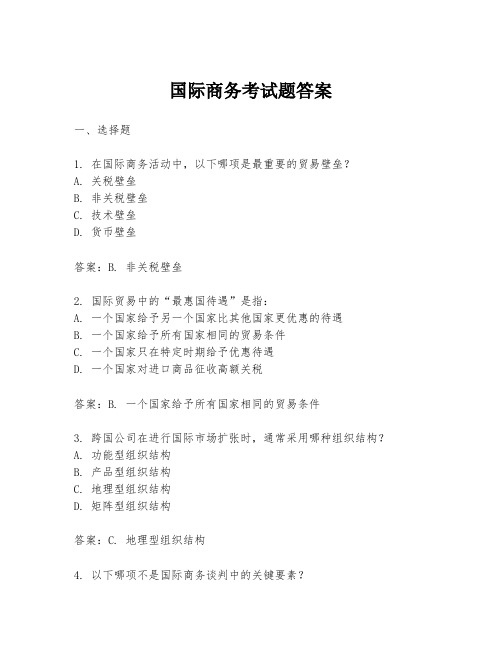
国际商务考试题答案一、选择题1. 在国际商务活动中,以下哪项是最重要的贸易壁垒?A. 关税壁垒B. 非关税壁垒C. 技术壁垒D. 货币壁垒答案:B. 非关税壁垒2. 国际贸易中的“最惠国待遇”是指:A. 一个国家给予另一个国家比其他国家更优惠的待遇B. 一个国家给予所有国家相同的贸易条件C. 一个国家只在特定时期给予优惠待遇D. 一个国家对进口商品征收高额关税答案:B. 一个国家给予所有国家相同的贸易条件3. 跨国公司在进行国际市场扩张时,通常采用哪种组织结构?A. 功能型组织结构B. 产品型组织结构C. 地理型组织结构D. 矩阵型组织结构答案:C. 地理型组织结构4. 以下哪项不是国际商务谈判中的关键要素?A. 文化差异B. 语言沟通C. 法律法规D. 产品质量答案:D. 产品质量5. 国际商务中的风险管理主要包括哪些方面?A. 市场风险B. 信用风险C. 操作风险D. 所有以上选项答案:D. 所有以上选项二、简答题1. 请简述国际商务中文化差异的影响及其应对策略。
文化差异在国际商务中可能导致沟通障碍、管理困难和市场误解等问题。
应对策略包括:增强文化意识,通过培训和教育提高对不同文化的理解和尊重;采用灵活的沟通方式,避免直译和文化刻板印象;在谈判和合同制定中考虑到文化因素,确保双方的共同理解和利益;以及建立多元化的团队,利用不同文化背景的员工的知识和经验。
2. 描述国际商务中的货币兑换风险及其管理方法。
货币兑换风险是指由于汇率波动导致的国际交易成本和收益的不确定性。
管理方法包括:使用远期合约锁定汇率,减少未来汇率变动的影响;通过多元化货币结构,分散汇率风险;采用货币期权策略,为汇率变动提供保险;以及进行内部对冲,通过内部交易来平衡不同货币的现金流。
3. 阐述国际商务中知识产权保护的重要性及其实施策略。
知识产权保护在国际商务中至关重要,因为它可以保护企业的创新成果和技术优势,防止侵权和不公平竞争。
国际商务习题{章复习题}
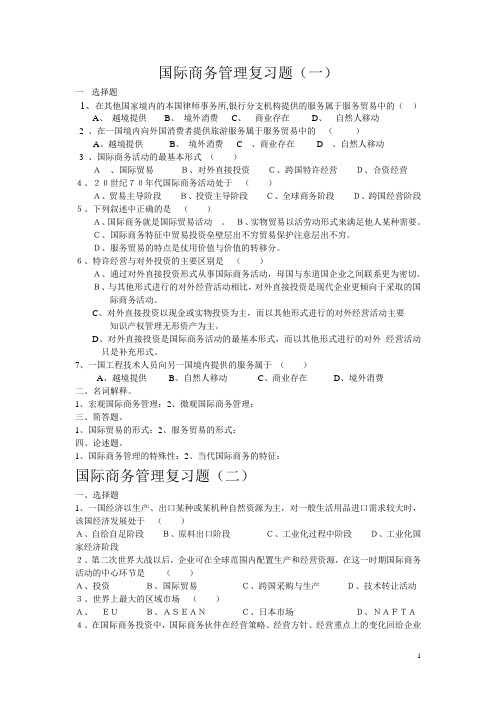
国际商务管理复习题(一)一选择题1、在其他国家境内的本国律师事务所,银行分支机构提供的服务属于服务贸易中的()A、越境提供B、境外消费C、商业存在D、自然人移动2 、在一国境内向外国消费者提供旅游服务属于服务贸易中的()A、越境提供B、境外消费 C 、商业存在 D 、自然人移动3 、国际商务活动的最基本形式()A、国际贸易B、对外直接投资C、跨国特许经营D、合资经营4、20世纪70年代国际商务活动处于()A、贸易主导阶段B、投资主导阶段C、全球商务阶段D、跨国经营阶段5、下列叙述中正确的是()A、国际商务就是国际贸易活动。
B、实物贸易以活劳动形式来满足他人某种需要。
C、国际商务特征中贸易投资垒壁层出不穷贸易保护注意层出不穷。
D、服务贸易的特点是仗用价值与价值的转移分。
6、特许经营与对外投资的主要区别是()A、通过对外直接投资形式从事国际商务活动,母国与东道国企业之间联系更为密切。
B、与其他形式进行的对外经营活动相比,对外直接投资是现代企业更倾向于采取的国际商务活动。
C、对外直接投资以现金或实物投资为主,而以其他形式进行的对外经营活动主要知识产权管理无形资产为主。
D、对外直接投资是国际商务活动的最基本形式,而以其他形式进行的对外经营活动只是补充形式。
7、一国工程技术人员向另一国境内提供的服务属于()A、越境提供B、自然人移动C、商业存在D、境外消费二、名词解释。
1、宏观国际商务管理:2、微观国际商务管理:三、简答题。
1、国际贸易的形式:2、服务贸易的形式:四、论述题。
1、国际商务管理的特殊性:2、当代国际商务的特征:国际商务管理复习题(二)一、选择题1、一国经济以生产、出口某种或某机种自然资源为主,对一般生活用品进口需求较大时,该国经济发展处于()A、自给自足阶段B、原料出口阶段C、工业化过程中阶段D、工业化国家经济阶段2、第二次世界大战以后,企业可在全球范围内配置生产和经营资源,在这一时期国际商务活动的中心环节是()A、投资B、国际贸易C、跨国采购与生产D、技术转让活动3、世界上最大的区域市场()A、EUB、ASEANC、日本市场D、NAFTA4、在国际商务投资中,国际商务伙伴在经营策略、经营方针、经营重点上的变化回给企业带来()A、信用风险B、商业风险C、汇兑风险D、价格风险5、WTO的最高决策机构()A、部长会议B、分理事会C、秘书处D、总理事会6、严格来说属于国家指导经济的国家()A、美国B、英国C、德国D、日本7、IBRD最年轻的机构是()A、IDAB、IFCC、MIGAD、ICSID8、工作重点为国际性交易和收入问题、商业仲裁问题及国际航运法令问题在UN内设立的机构是()A、IMFB、WTOC、UNCTRALD、ISO9、没有政府参与经济系统中的个人或企业本着自身利益最大化的原则,做出与自身有关的所有经济决策,这一经济体制的类型是()A、市场经济B、指令经济C、混合经济D、转轨经济10、企业从事国际商务活动时,最常见的贸易垒壁是()A、技术标准B、配额C、许可证D、关税11、直接影响企业营销成本和销售量人口的因素是()A、人口总量B、人口增长C、人口分布D、人口素质12、中国加入WTO组织以后,美国必须无条件给予中国()A、普通关税待遇B、最惠国待遇C、特惠国待遇D、普通优惠制和待遇13、WTO框架下,重要似的决定是()A、经过半数以上一致通过做出的B、经过协商一致作出的C、经过反向一致的做法进行决定D、只要不是多数一致反对有关决策就可做出14、在EU有一关于人员自由流通的申报协议,没有签署这一协议的国家是(A、荷兰和挪威B、冰岛和挪威C、英国和爱尔兰D、冰岛爱尔兰15、东盟目前存在的服务贸易障碍中,最多的障碍是()A、行政程序繁杂B、内陆运输不便C、通讯设备不足D、限制外资比例16、在GATT的乌拉圭回合的谈判协议中,将公平贸易原则扩大到过去长期游离与协定之外的()A、服务贸易领域B、知识产权领域C、工业关税领域D、投资措施领域17、法国、意大利和瑞典的经济体制都可以划为()A、市场经济B、国家指导经济C、混合经济D、转轨经济18、要想成为其他有关工业产权条约的成员国,首先要加入在工业产权方面最有影响的国家公约即()A、联合国法规委员会B、保护工业产权巴黎公约C、专利合作公约D、商标国际注册马德里协定19、下列国家不属于EU成员,但属于原欧洲自由贸易联盟,且与EU之间完全取消了关税的是()A、英国B、挪威C、丹麦D、瑞典20、20世纪90年代后,巴西产品最的市场是()A、USAB、EUC、墨西哥D、阿根廷二、名词解释1、最惠国待遇原则:2、国民待遇原则:3、国家指导经济:4、公平贸易原则;三、简答题。
国际商务测试题与参考答案

国际商务测试题与参考答案一、单选题(共50题,每题1分,共50分)1、属于自由贸易理论的是A、贸易乘数理论B、贸易差额论C、绝对成本论D、货币差额论正确答案:C2、资本主义国家实行进口数量限制的重要手段是A、进口管制B、外汇管制C、进口押金制D、进口配额制正确答案:D3、环境壁垒也称为A、绿色贸易壁垒B、商品包装壁垒C、技术壁垒D、卫生安全壁垒正确答案:A4、最具有典型意义的公司一体化战略是A、复合一体化战略B、简单一体化战略C、多国国内战略D、纵向一体化战略正确答案:A5、跨国公司实现本地化的一般途径是A、加大投资金额B、购买当地品牌C、对研发进行投资D、雇佣当地人员正确答案:C6、杠杆收购于20世纪60年代出现于A、美国B、日本C、英国D、法国正确答案:A7、国际商务谈判中谈判双方互相了解和收集情报的阶段是A、分析阶段B、策划阶段C、讨论阶段D、实施阶段正确答案:A8、投资动因是降低产品成本、追求竞争优势和更多的利润,这种跨国直接投资导向是A、低成本导向型B、先进技术导向型C、市场导向型D、自然资源导向型正确答案:A9、独家许可、从属许可和混合许可都属于A、独占许可B、中性许可C、普通许可D、交叉许可正确答案:B10、国际商务合作双方实质性接触的开始是A^还盘B、发盘C、签约D、询盘正确答案:D11、跨国公司转移利润的主要表现是A、转移产品B、调节价格C、转移成本D、合理避税正确答案:D12、现代的租赁贸易起源于A、法国B、美国C、日本D、英国正确答案:B13、在历史上第一次从生产领域出发,说明国际贸易发生与发展必然性的理论是A、绝对成本论B、比较成本论C、重商主义D、要素禀赋说正确答案:A14、世界贸易组织成员如有争端,应先行协商,在一方提出要求后必须开始协商的时限为A、60B、120C、90D、30正确答案:D15、商品生产国与商品消费国通过第三国进行的贸易,对第三国而言是A、过境贸易B、转口贸易C、直接贸易Ds多边贸易正确答案:B16、目前对跨国公司及直接投资影响最大的一种理论是A、垄断优势理论B、国际生产折衷理论C、竞争优势理论D、产品周期理论正确答案:B17、在国际商务谈判中,接受和发盘一样A、只属于法律行为B、只属于商业行为C、只属于交易行为D、既属于商业行为,也属于法律行为正确答案:D18、将取之于对外贸易中的货币仅作为财富珍藏下来,而不再投入对外贸易流通的理论称之为A、贸易平衡论B、贸易差额论C、贸易乘数理论D、货币差额论正确答案:D19、对于实行商品倾销的进口商品所征收的进口附加税是A、反倾销税B、差价税C、特惠税D、反补贴税正确答案:A20、普惠制的主要原则不包括A、特殊的B、非互惠的C、普遍的D、非歧视的正确答案:A21、我国海关正式采用《商品名称及编码协调制度》(HS)的时间是A、1996B、1992C、1994D、1993正确答案:B22、仅适用于海运和内河运输的国际贸易术语是A、FOB、FCC、CPTD、CIP正确答案:A23、在第一次世界大战与第二次世界大战之间盛行的贸易保护政策是A、早期重商主义B、新贸易保护主义C、晚期重商主义D、超保护贸易主义正确答案:D24、大卫•李嘉图的代表作是A、《国富论》B、《英国得自对外贸易的财富》C、《政治经济学及赋税原理》D、《就业、利息和货币通论》正确答案:C25、一国政府在一定时期以内,对某些商品的进口数量或金额加以直接的限制称为A、“自动”出口限制B、进口许可证制C、进口配额制D、进口押金制正确答案:C26、征税引起的进口量的变化称为A、消费效应B、生产效应C、贸易效应D、财政产应正确答案:C27、当今世界最大的服务贸易国是A^英国B、法国C、日本D、美国正确答案:D28、在租赁贸易中,连接货物的生产者和使用者的纽带是A、供货人B、出资人C、出租人D>承租人正确答案:C29、世界各国(地区)之间货物和服务交换的活动称为A、出口贸易B、进出口贸易C、进口贸易D、国际贸易正确答案:D30、凯恩斯的代表作是A、《政治经济学及赋税原理》B、《国富论》C、《就业、利息和货币通论》D、《政治经济学的国民体系》正确答案:C31、属于国际投资硬环境因素的是A^劳工素质B、管理水平C、社会文化D、自然资源正确答案:D32、货物的有关保险手续应当由卖方负责办理的国际贸易术语是B、FOC、CID、CPT正确答案:C33、一般代理又称A、佣金代理B、协议代理C、合同代理D、独家代理正确答案:A34、国际服务活动中最主要的方式是A、过境交付B、境外消费C、自然人流动D、商业存在正确答案:D35、1974年美国在其贸易法第301条款中首次使用的概念是A、世界贸易组织B、世界服务贸易C^跨国公司D、经济全球化正确答案:B36、为证明增加新投资对就业和国民收入的好处,凯恩斯提出了A、投资乘数理论B、偏好相似理论C、比较成本理论D、绝对成本理论正确答案:A37、世界贸易组织建立的时间是A、2001C、1993D、1991正确答案:B38、企业并购属于跨国直接投资的A、股权安排方式B、非股权安排方式C、BOTD、TOT正确答案:A39、产品周期理论的首创者是A、波特B、海默C、邓宁D、维农正确答案:D40、在19世纪初就被广泛采用的贸易术语是A、FOB、CFRC、CID、FCA正确答案:A41、推动经济全球化的主体是Λ^跨国公司B、国际货币基金组织C、世界银行D、世界贸易组织正确答案:A42、跨国生产本地化不包括A、人员本地化B、利润本地化C、管理本地化D、生产本地化正确答案:A43、跨国公司实现规模经济、提高全球生产效率的最基本条件是A、对员工进行东道国语言培训B、使员工适应东道国的文化C、产品及其生产过程的标准化D、给予员工有竞争力的报酬正确答案:C44、国际投资环境的特点不包括A、综合性B、动态性C、系统性D、安全性正确答案:D45、资本主义早期的国际贸易理论是A、重商主义B、凯恩斯主义C、重农主义D、超保护贸易主义正确答案:A46、普通许可又称A、交叉许可B、一般许可C、中性许可D、从属许可正确答案:B47、关税按照其保护的程度和有效性分类可分为A、财政关税和保护关税B、名义关税和有效关税C、进口附加税、差价税和特惠税D、进口税、出口税和过境税正确答案:B48、最先采用投资环境分析法的美国经济学家是A、伊西•利特瓦克B、彼得•拜廷C、罗伯特•斯托鲍夫D、威德尔希姆•保罗正确答案:C49、从世界经济相互联接的紧密性上说,世界经济一体化发展中最深刻的表现形式是A、跨国公司B、世界银行C、关贸总协定D、国际货币基金组织正确答案:A50、收购公司并不向目标公司直接提出购并的要求,而是通过在市场上收购目标公司已发行和流通的具有表决权的普通股票,从而取得目标公司控制权的行为称为A、协议收购B、友好接管C、直接并购D、间接并购正确答案:D二、多选题(共50题,每题1分,共50分)k IS014000系列标准是一套一体化的国际标准,包括A、环境标志B、环境绩效评价C、环境管理体系D、产品生命周期评价E、环境审核正确答案:ABCDE2、属于贸易保护理论的有A、贸易乘数理论B、货币差额论C、贸易差额论D、绝对成本论E、比较成本论正确答案:ABC3、属于直接非关税壁垒的有A、“自动”出口限制B、最低限价制C、进口许可证制D、进口配额制E、进口押金制正确答案:ACD4、补偿贸易的做法有A、直接产品补偿法B、技术补偿法C、劳务补偿法D、加工补偿法E、间接产品补偿法正确答案:ACE5、反倾销法限制的倾销有A、产品倾销B、运费倾销C、服务倾销D、社会倾销E、间接倾销正确答案:ADE6、跨国公司一体化战略的类型有A、复合一体化战略B、简单一体化战略C、多国国内战略D、纵向一体化战略E、横向一体化战略正确答案:ABC7、自由贸易理论的代表人物有A、俄林B、大卫・李嘉图C、赫克歇尔D、托马斯•孟E、亚当•斯密正确答案:ABCE8、适用于各种运输方式的国际贸易术语有A、CIPB、CFRC、CID、FCE、CPT正确答案:ADE9、属于间接非关税壁垒的有A、进口许可证制B、最低限价制C、海关估价制D、“自动”出口限制E、进口押金制正确答案:BCE10、商品采购中的招标投标业务的基本步骤有A、履行和约B、签订合约C、招标D、投标E、开标和评标正确答案:BCDE11、影响跨国公司经营的各种文化要素有A、行为方式与习惯B、宗教C、审美D、教育E、语言正确答案:ABCDE12、国际服务贸易的表现形式主要有A、商业存在B、境外消费C、境内消费D、过境交付E、自然人流动正确答案:ABDE13、国际商务谈判人员应具备的业务素质有A、精通外语B、心理素质C、市场经验D、有驻外经历E、专业知识正确答案:BCE14、撰写可行性研究报告需要较规范的内容,主要包括A、产业政策B、定价策略C^需求分析D、市场进入方案E、市场分析正确答案:ABCDE15、属于国际投资硬环境因素的有A、劳工素质B、能源供应C、基础设施D、政治稳定性E、自然资源正确答案:BCE16、国际生产折衷理论提出的决定一国企业对外直接投资的变量有A、所有权优势B、内部化优势C、区位优势D、技术优势E、资金优势正确答案:ABC17、跨国公司转移利润的主要表现有A、调节价格B、利润调节C、转移成本D、合理避税E、转移资金正确答案:BDE18、在两届部长会议之间,负责处理世界贸易组织日常工作的有A、总理事会B、贸易政策审议机构C、分理事会D、争端解决机构E、专门委员会正确答案:ABD19、目前在国际上受到跨国公司关注的人力资源管理战略主要有A、东道国语言培训B、适应东道国的文化C、帮助员工移民海外D、帮助员工子女在海外学习E、给予员工有竞争力的报酬正确答案:ABE20、美国麻省理工学院著名教授罗宾逊根据企业管理结构的演变及其在国外销售额增长情况,将处于不同发展阶段的企业主要分成A、出口型公司B、国际公司C、多国公司D、跨国公司E、内向型公司正确答案:ABCDE21、波特认为一个国家的内部竞争环境的形成因素有A、需求状况B、要素禀赋C、相关产业和辅助产业D、公司的策略、结构和竞争E、供给状况正确答案:ABCD22、关税的国内效应包括A、财政效应B、消费效应C、生产效应D、贸易效应E、再分配效应正确答案:ABCDE23、从收购者与被收购者的关系上来看,跨国公司对外国企业的收购可以分为A、纵向型收购B、横向型收购C、集中型收购D、混合型收购E、全部收购正确答案:ABCD24、不属于反倾销法调整范围的倾销有A、外汇倾销B、产品倾销C、运费倾销D、社会倾销E、服务倾销正确答案:ACE25、国际技术许可根据许可人和被许可人权利义务关系,可分为A、交叉许可B、中性许可C、特定许可D、独占许可E、普通许可正确答案:ABDE26、普惠制的主要原则有A、非互惠的B、非歧视的C、普遍的D、互惠的E、歧视的正确答案:ABC27、货物的风险在其越过船舷后由卖方转移至买方的国际贸易术语有A、FOB、CFRC、CID、FCE、CPT正确答案:ABC28、属于国际投资软环境因素的有A、自然资源B、社会文化C、劳工素质D、管理水平E、政治稳定性正确答案:BCDE29、企业并购的基本方法有A、许可证合同B、股票收购C、资产收购D、杠杆收购E、现金收购正确答案:BDE30、国际投资的环境因素有A、政治环境B、经济环境C、法律环境D、自然环境E、文化环境正确答案:ABCDE31、国际技术贸易一般是技术商品使用权的转让,主要包括A、肖像使用权B、商标使用权C、专有技术使用权D、著作使用权E、专利使用权正确答案:BCE32、中国环境保护的制度有A、限期治理B、环境影响评价C、污染集中控制D、排污许可证E、排污收费正确答案:ABCDE33、技术是一种无形资产,按变化程度可分为A、原有技术B、新技术C、落后技术D、改进技术E、先进技术正确答案:ABD34、跨国公司采取并购的方式进行投资的动机有A、地区多元化B、获取特定的技术C、产品多样化D、资金多元化E、进行生产正确答案:ABCDE35、国际货物买卖和服务贸易中的代理按委托人的授权分为A、合同代理B、协议代理C、一般代理D、总代理E、独家代理正确答案:CDE36、国际独资企业的形式主要有A、国外避税地公司Bs国外子公司C、国外合资公司D、国外公司集团E、国外分公司正确答案:ABE37、关税税收筹划的方法通常有A、利用保税制度B、利用税法漏洞C、利用纳税时间D、利用优惠政策E、利用完税价格正确答案:ACDE38、关税按照征税的一般方法或征税标准分类可分为A、从量税B、附加税C、选择税D、从价税E、混合税正确答案:ACDE39、技术是一种无形资产,按先进程度可分为A、原有技术B、中间技术C、新技术D、先进技术E、落后技术正确答案:BDE40、世贸组织总理事会下设的分理事会有A、与贸易有关的知识产权理事会B、技术贸易理事会C、服务贸易理事会D、国际投资理事会E、货物贸易理事会正确答案:ACE41、中国环境保护的政策有A、污染集中控制B、排污收费C、预防为主D、谁污染谁治理E、强化管理正确答案:CDE42、古典自由贸易理论有A、货币差额论B、要素禀赋说C、比较成本论D、贸易差额论E、绝对成本论正确答案:CE43、许可证贸易的标的有A^工业设计B、专有技术C、商标D、商业咨询E、专利正确答案:ABCE44、撰写可行性研究报告的目的有A、给投资者决策提供依据B、为银行贷款提供依据C、为同合作者签约提供依据D、为跨国经营和防范风险提供依据E、为工程设计提供依据正确答案:ABCDE45、属于中性许可的有A、相互许可B、独家许可C、从属许可Ds混合许可E、交叉许可正确答案:BCD46、属于自然人流动的有A、出国留学B、境外投资建厂C、境外讲学D、境外务工E、国外就医正确答案:CD47、仅适用于海运和内河运输的国际贸易术语有A、FOB、CFRC、CID、FCE、CPT正确答案:ABC48、经济特区的类型有A、自由边境区B、出口加工区C、保税区D、科学工业园区E、自由港正确答案:ABCDE49、贸易保护理论的代表人物有A、博丹B、孟克列钦C、柯尔培尔D、斯塔福德E、托马斯•孟正确答案:ABCDE50、跨文化培训一般包括A、现场体验B、语言训练C、文化介绍D、敏感性训练E、环境介绍正确答案:ABCDE。
国际商务试题答案

国际商务试题答案一、选择题1. 在国际商务活动中,以下哪项是最重要的贸易壁垒?A. 关税壁垒B. 非关税壁垒C. 技术壁垒D. 配额制度答案:B. 非关税壁垒2. 国际贸易中的“最惠国待遇”是指:A. 给予所有国家相同的贸易优惠B. 仅给予特定国家贸易优惠C. 仅给予邻国贸易优惠D. 仅给予发达国家贸易优惠答案:A. 给予所有国家相同的贸易优惠3. 跨国公司在进行国际扩张时,通常采用的直接投资形式是:A. 出口B. 特许经营C. 合资企业D. 全资子公司答案:D. 全资子公司4. 在国际商务谈判中,以下哪种策略最有助于建立长期合作关系?A. 强硬谈判B. 让步策略C. 合作策略D. 竞争策略答案:C. 合作策略5. 国际商务环境中,文化差异对商业活动的影响主要体现在哪些方面?A. 管理方式B. 沟通方式C. 决策过程D. 所有以上方面答案:D. 所有以上方面二、简答题1. 请简述国际商务中贸易保护主义的主要表现形式及其可能带来的影响。
答:贸易保护主义主要通过实施高关税、配额制度、技术标准和行政干预等手段来限制进口商品,保护本国产业。
这种做法可能导致国际贸易紧张关系加剧,全球贸易效率降低,最终可能引起贸易战,损害全球经济的健康发展。
2. 阐述国际商务中文化适应性的重要性及其对企业成功的作用。
答:文化适应性在国际商务中至关重要,因为它涉及到理解和尊重不同文化背景下的商业习惯和交流方式。
具备良好文化适应性能力的企业和个人能够更有效地与不同国家的合作伙伴沟通,建立信任,从而促进谈判成功、合同签订和长期合作关系的建立。
3. 描述国际商务中汇率波动对企业的影响,并提出应对策略。
答:汇率波动会影响企业的成本、定价、利润和竞争力。
企业可以通过多种策略来应对汇率风险,包括使用远期合约和期权锁定汇率、多元化货币结算、以及在不同国家间分散投资以降低单一货币波动的影响。
三、案例分析题某中国企业计划在印度建立制造工厂,以降低生产成本并更好地进入当地市场。
国际商务复习题答案
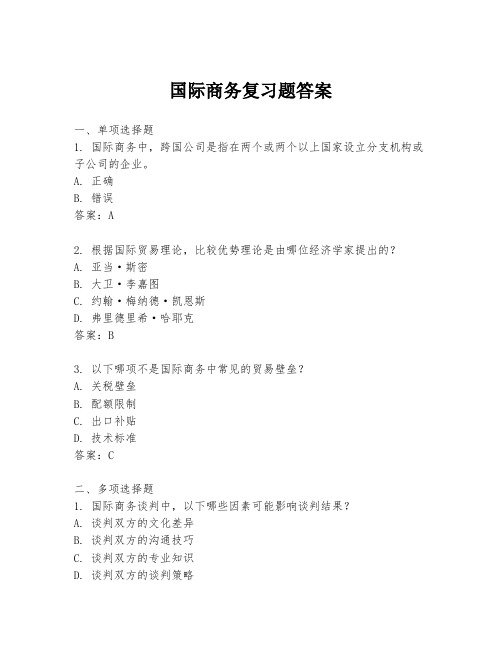
国际商务复习题答案一、单项选择题1. 国际商务中,跨国公司是指在两个或两个以上国家设立分支机构或子公司的企业。
A. 正确B. 错误答案:A2. 根据国际贸易理论,比较优势理论是由哪位经济学家提出的?A. 亚当·斯密B. 大卫·李嘉图C. 约翰·梅纳德·凯恩斯D. 弗里德里希·哈耶克答案:B3. 以下哪项不是国际商务中常见的贸易壁垒?A. 关税壁垒B. 配额限制C. 出口补贴D. 技术标准答案:C二、多项选择题1. 国际商务谈判中,以下哪些因素可能影响谈判结果?A. 谈判双方的文化差异B. 谈判双方的沟通技巧C. 谈判双方的专业知识D. 谈判双方的谈判策略答案:ABCD2. 国际市场营销中,以下哪些因素属于宏观环境因素?A. 政治法律环境B. 经济环境C. 社会文化环境D. 技术环境答案:ABCD三、判断题1. 国际商务中的文化适应性是指企业能够根据不同国家的文化特点调整其经营策略和管理方式。
答案:正确2. 国际贸易中的最惠国待遇是指一个国家给予另一个国家的最优惠待遇不得低于给予任何其他国家的待遇。
答案:正确四、简答题1. 简述国际商务中市场进入模式的主要类型及其特点。
答:国际商务中市场进入模式主要包括出口、许可贸易、特许经营、合资企业、全资子公司等。
出口模式是企业将产品直接销售到国外市场,操作简单但风险较高。
许可贸易是企业授权外国企业使用其技术或品牌,收取许可费,风险较低但收益也有限。
特许经营是企业授权外国企业按照一定的标准和流程经营,可以快速扩张市场。
合资企业是与外国企业共同投资设立公司,可以共享资源和风险。
全资子公司是企业在国外设立完全控制的子公司,对市场有完全的控制权,但风险和投资也最大。
2. 描述国际商务中供应链管理的重要性。
答:国际商务中的供应链管理对于企业的成功至关重要。
它涉及到从原材料采购、产品制造、物流配送到最终销售的全过程。
有效的供应链管理可以降低成本、提高效率、增强客户满意度,并提高企业的竞争力。
国际商务复习题
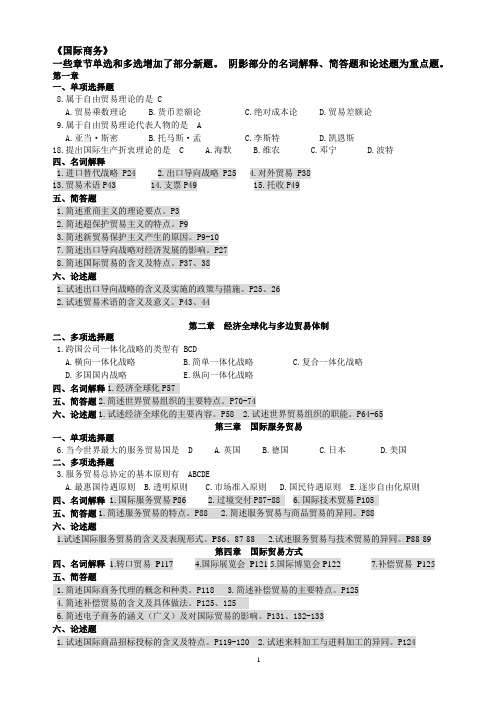
《国际商务》一些章节单选和多选增加了部分新题。
阴影部分的名词解释、简答题和论述题为重点题。
第一章一、单项选择题8.属于自由贸易理论的是 CA.贸易乘数理论B.货币差额论C.绝对成本论D.贸易差额论9.属于自由贸易理论代表人物的是 AA.亚当·斯密B.托马斯·孟C.李斯特D.凯恩斯18.提出国际生产折衷理论的是 C A.海默 B.维农 C.邓宁 D.波特四、名词解释1.进口替代战略 P242.出口导向战略 P25 4.对外贸易 P3813.贸易术语P43 14.支票P49 15.托收P49五、简答题1.简述重商主义的理论要点。
P32.简述超保护贸易主义的特点。
P93.简述新贸易保护主义产生的原因。
P9-107.简述出口导向战略对经济发展的影响。
P278.简述国际贸易的含义及特点。
P37、38六、论述题1.试述出口导向战略的含义及实施的政策与措施。
P25、262.试述贸易术语的含义及意义。
P43、44第二章经济全球化与多边贸易体制二、多项选择题1.跨国公司一体化战略的类型有 BCDA.横向一体化战略B.简单一体化战略C.复合一体化战略D.多国国内战略E.纵向一体化战略四、名词解释1.经济全球化P57五、简答题2.简述世界贸易组织的主要特点。
P70-74六、论述题1.试述经济全球化的主要内容。
P58 2.试述世界贸易组织的职能。
P64-65第三章国际服务贸易一、单项选择题6.当今世界最大的服务贸易国是 D A.英国 B.德国 C.日本 D.美国二、多项选择题3.服务贸易总协定的基本原则有 ABCDEA.最惠国待遇原则B.透明原则C.市场准入原则D.国民待遇原则E.逐步自由化原则四、名词解释 1.国际服务贸易P86 2.过境交付P87-88 6.国际技术贸易P105五、简答题1.简述服务贸易的特点。
P88 2.简述服务贸易与商品贸易的异同。
P88六、论述题1.试述国际服务贸易的含义及表现形式。
国际商务复习题
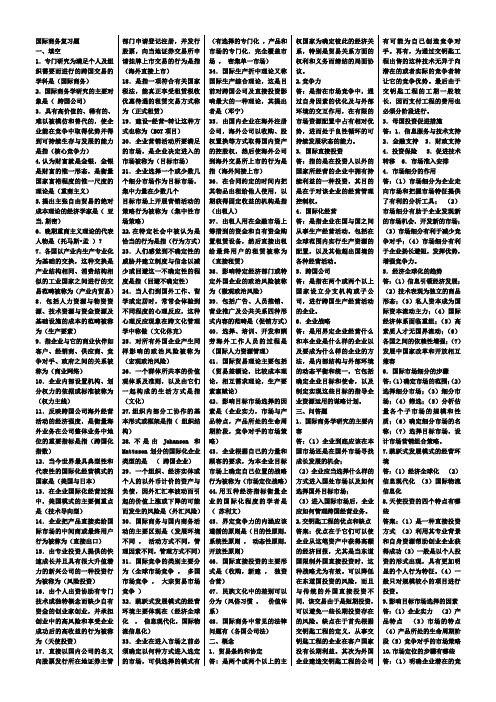
国际商务复习题一、填空1.专门研究为满足个人及组织需要而进行的跨国交易的学科是(国际商务)2.国际商务学研究的主要对象是(跨国公司)3.具有高价值的、稀有的、难以被模仿和替代的,使企业能在竞争中取得优势并得到可持续生存与发展的能力是指(核心竞争力)4.认为财富就是金银,金银是财富的惟一形态,是衡量国家富裕程度的惟一尺度的理论是(重商主义)5.提出主张自由贸易的绝对成本理论的经济学家是(亚当.斯密)6.晚期重商主义理论的代表人物是(托马斯•孟)?7.各国以产业内生产专业化为基础的交换,这种交换是产业结构相同、消费结构相似的工业国家之间进行的交易范畴被称为(产业内贸易)8.包括人力资源与物资资源、技术资源与资金资源及基础设施的成本的范畴被称为(生产要素)9.指企业与它的商业伙伴如客户、经销商、供应商、竞争对手、政府之间的关系被称为(商业网络)10.企业内部设置机构、划分权力的依据或标准被称为(权力主线)11.反映跨国公司海外经营活动的经济强度,是衡量海外业务在公司整体业务中地位的重要指标是指(跨国化指数)12.当今世界最具典型性和代表性的国际化经营模式的国家是(美国与日本)13.在企业国际化经营过程中,美国模式的主要侧重点是(技术导向型)14.企业把产品直接卖给国际市场的中间商或最终用户行为被称为(直接出口)15.由专业投资人提供的快速成长并且具有很大升值潜力的新兴公司的一种投资行为被称为(风险投资)16.由个人出资协助有专门技术或独特概念而缺少自有资金的创业家创业,并承担创业中的高风险和享受企业成功后的高收益的行为被称为(天使投资)17.直接以国内公司的名义向股票发行所在地证券主管部门申请登记注册,并发行股票,向当地证券交易所申请挂牌上市交易的行为是指(海外直接上市)18.是指一项符合有关国家税法,能真正享受租赁税收优惠待遇的租赁交易方式称为(正式租赁)19.建设-经营-转让这种方式也称为(BOT项目)20.企业营销活动所要满足的市场,是企业决定进入的市场被称为(目标市场)21.企业选择一个或少数几个细分市场作为目标市场,集中力量在少数几个目标市场上开展营销活动的策略行为被称为(集中性市场策略)22.在特定社会中被认为是恰当的行为是指(行为方式)23.人们感觉到不确定性的威胁并建立制度与信念以减少或回避这一不确定性的程度是指(回避不确定性)24.当人们到国外工作、留学或定居时,常常会体验到不同程度的心理反应,这种心理反应现象在跨文化管理学中称做(文化休克)25.对所有外国企业产生同样影响的政治风险被称为(宏观政治风险)26.一个群体所共享的价值观体系及准则,以及由它们一起构成的生活方式是指(文化)27.组织内部分工协作的基本形式或框架是指(组织结构)28.不是由Johanson和Mattsson划分的国际化企业类型的是(跨国企业)29.一个组织、经济实体或个人的以外币计价的资产与负债,因外汇汇率波动而引起的价值上涨或下降的可能而发生的风险是(外汇风险)30.国际商务与国内商务活动的主要区别是(发展环境不同,活动方式不同,管理因素不同,管理方式不同)31.国际竞争的类别主要分为(全球市场竞争,多国市场竞争,大宗贸易市场竞争)32.跳跃式发展模式的经营环境主要体现在(经济全球化,信息现代化,国际物流信息化)33.企业在进入市场之前必须确定以何种方式进入选定的市场,可供选择的模式有(有选择的专门化,产品和市场的专门化.完全覆盖市场,密集单一市场)34.国际生产折中理论又称国际生产综合理论,这是目前对跨国公司及直接投资影响最大的一种理论,其提出者是(邓宁)35.由国内企业在海外注册公司,海外公司以收购、股权置换等方式取得国内资产的控股权,然后使海外公司到海外交易所上市的行为是指(海外间接上市)36.在合同约定的时间内把其物品出租给他人使用,以期获得固定收益的机构是指(出租人)37.出租人用在金融市场上筹措到的资金和自有资金购置租赁设备,然后直接出租给最终用户的租赁被称为(直接租赁)38.影响特定经济部门或特定外国企业的政治风险被称为(微观政治风险)39.包括广告、人员推销、营业推广及公共关系四种形式内容的范畴是(促销方式)40.选择、培训、开发和酬劳海外工作人员的过程是(国际人力资源管理)41.国际贸易理论主要包括(贸易差额论,比较成本理论,相互需求理论,生产要素禀赋论)42.影响目标市场选择的因素是(企业实力,市场与产品特点,产品所处的生命周期阶段,竞争对手的市场策略)43.企业根据自己的力量和顾客的要求,为本企业目标市场上确定自己位置的战略行为被称为(市场定位战略)44.用五种经济指标衡量企业的国际化程度的学者是(苏利文)45.界定竞争力的内涵应该遵循的原则是(目的性原则,系统性原则,动态性原则,开放性原则)46.国际直接投资的主要形式是(收购,新建,独资合营)47.民族文化中的差别可以分为(风俗习惯,价值体系)48.国际商务中常见的法律问题有(各国公司法)二、概念1.贸易条约和协定答: 是两个或两个以上的主权国家为确定彼此的经济关系,特别是贸易关系方面的权利和义务而缔结的局面协议。
国际商务试题及答案

国际商务试题及答案一、选择题(每题2分,共20分)1. 国际商务中,跨国公司通常采用哪种组织结构来管理其全球业务?A. 功能型结构B. 地理型结构C. 产品型结构D. 矩阵型结构2. 根据波特的五力模型,以下哪一项不是行业竞争力量?A. 供应商的议价能力B. 潜在的新进入者C. 替代品的威胁D. 政府政策3. 在国际市场进入模式中,哪种方式允许企业获得最大的控制权?A. 出口B. 许可经营C. 特许经营D. 直接投资4. 国际商务中,文化差异对以下哪个方面影响最大?A. 产品定价B. 营销策略C. 人力资源管理D. 财务报告5. 以下哪个不是国际商务中常见的风险类型?A. 政治风险B. 汇率风险C. 信用风险D. 技术风险二、简答题(每题10分,共30分)6. 简述国际商务中的全球化与多国本土化的区别。
7. 描述国际商务谈判中文化因素的重要性及其对谈判结果可能产生的影响。
8. 解释国际商务中的“适应性”概念,并举例说明企业如何实现适应性。
三、案例分析题(每题25分,共50分)9. 假设你是一家国际公司的市场部经理,公司计划进入一个新的亚洲市场。
请分析进入该市场可能面临的主要挑战,并提出相应的市场进入策略。
10. 某跨国公司在东道国遭遇了政治不稳定,导致其业务受到严重影响。
请分析该公司可能采取的应对措施,并讨论这些措施的潜在效果和风险。
国际商务试题答案一、选择题1. D. 矩阵型结构2. D. 政府政策3. D. 直接投资4. B. 营销策略5. D. 技术风险二、简答题6. 全球化是指企业在全球范围内统一其产品、服务和营销策略,以实现规模经济和市场效率。
而多国本土化则是指企业根据不同国家的市场特点,调整其产品和营销策略以满足当地消费者的需求。
7. 文化因素在国际商务谈判中至关重要,它影响谈判双方的交流方式、决策过程和信任建立。
文化差异可能导致误解和沟通障碍,从而影响谈判结果。
8. “适应性”是指企业根据外部环境的变化调整其战略和运营,以提高竞争力。
《国际商务》复习题(16.10)
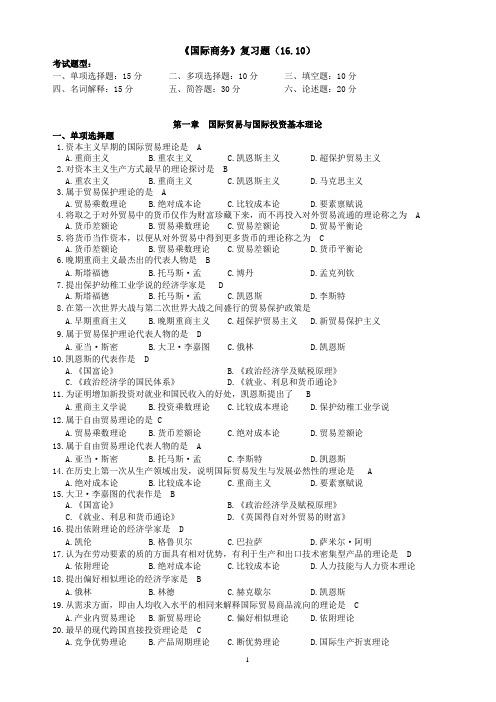
《国际商务》复习题(16.10)考试题型:一、单项选择题:15分二、多项选择题:10分三、填空题:10分四、名词解释:15分五、简答题:30分六、论述题:20分第一章国际贸易与国际投资基本理论一、单项选择题1.资本主义早期的国际贸易理论是 AA.重商主义B.重农主义C.凯恩斯主义D.超保护贸易主义2.对资本主义生产方式最早的理论探讨是 BA.重农主义B.重商主义C.凯恩斯主义D.马克思主义3.属于贸易保护理论的是 AA.贸易乘数理论B.绝对成本论C.比较成本论D.要素禀赋说4.将取之于对外贸易中的货币仅作为财富珍藏下来,而不再投入对外贸易流通的理论称之为 AA.货币差额论B.贸易乘数理论C.贸易差额论D.贸易平衡论5.将货币当作资本,以便从对外贸易中得到更多货币的理论称之为 CA.货币差额论B.贸易乘数理论C.贸易差额论D.货币平衡论6.晚期重商主义最杰出的代表人物是 BA.斯塔福德B.托马斯·孟C.博丹D.孟克列钦7.提出保护幼稚工业学说的经济学家是 DA.斯塔福德B.托马斯·孟C.凯恩斯D.李斯特8.在第一次世界大战与第二次世界大战之间盛行的贸易保护政策是A.早期重商主义B.晚期重商主义C.超保护贸易主义D.新贸易保护主义9.属于贸易保护理论代表人物的是 DA.亚当·斯密B.大卫·李嘉图C.俄林D.凯恩斯10.凯恩斯的代表作是 DA.《国富论》B.《政治经济学及赋税原理》C.《政治经济学的国民体系》D.《就业、利息和货币通论》11.为证明增加新投资对就业和国民收入的好处,凯恩斯提出了 BA.重商主义学说B.投资乘数理论C.比较成本理论D.保护幼稚工业学说12.属于自由贸易理论的是 CA.贸易乘数理论B.货币差额论C.绝对成本论D.贸易差额论13.属于自由贸易理论代表人物的是 AA.亚当·斯密B.托马斯·孟C.李斯特D.凯恩斯14.在历史上第一次从生产领域出发,说明国际贸易发生与发展必然性的理论是 AA.绝对成本论B.比较成本论C.重商主义D.要素禀赋说15.大卫·李嘉图的代表作是 BA.《国富论》B.《政治经济学及赋税原理》C.《就业、利息和货币通论》D.《英国得自对外贸易的财富》16.提出依附理论的经济学家是 DA.凯伦B.格鲁贝尔C.巴拉萨D.萨米尔·阿明17.认为在劳动要素的质的方面具有相对优势,有利于生产和出口技术密集型产品的理论是 DA.依附理论B.绝对成本论C.比较成本论D.人力技能与人力资本理论18.提出偏好相似理论的经济学家是 BA.俄林B.林德C.赫克歇尔D.凯恩斯19.从需求方面,即由人均收入水平的相同来解释国际贸易商品流向的理论是 CA.产业内贸易理论B.新贸易理论C.偏好相似理论D.依附理论20.最早的现代跨国直接投资理论是 CA.竞争优势理论B.产品周期理论C.断优势理论D.国际生产折衷理论21.产品周期理论的首创者是 BA.海默B.维农C.邓宁D.波特22.维农从美国制造业的情况出发,将产品周期分为三个阶段,其中不包括 DA.成熟产品阶段B.新产品阶段C.标准化产品阶段D.专业化产品阶段23.目前对跨国公司及直接投资影响最大的一种理论是 DA.竞争优势理论B.产品周期理论C.垄断优势理论D.国际生产折衷理论24.提出国际生产折衷理论的是 CA.海默B.维农C.邓宁D.波特25.国际生产折衷理论的核心是提出了三个决定一国企业对外直接投资的变量,其中不包括 AA.竞争优势B.所有权优势C.内部化优势D.区位优势26.世界各国(地区)之间货物和服务交换的活动称为 AA.国际贸易B.出口贸易C.进口贸易D.进出口贸易27.一国(地区)与其他国家(地区)之间商品和服务的交换活动称为 DA.国际贸易B.世界贸易C.全球贸易D.对外贸易28.一个国家(地区)在一定时期内出口额与进口额的相差数称为 CA.贸易顺差B.贸易逆差C.贸易差额D.国际收支差额29.一个国家在一定时期出口贸易额和进口贸易额之和称为 AA.对外贸易额B.对外贸易量C.国际贸易额D.国际贸易量30.世界各国出口贸易额的总和称为 BA.对外贸易额B.国际贸易额C.净出口额D.累计出口额31.出口商品价格与进口商品价格之间的比率称为 AA.贸易条件B.贸易差额C.出超D.入超32.用一个简短的概念或英文缩写字母来表示价格的构成和交易的其他条件,称为 CA.贸易方式B.贸易工具C.贸易术语D.贸易条件33.仅适用于海运和内河运输的国际贸易术语是 AA.FOBB.FCAC.CPTD.CIP34.适用于各种运输方式的国际贸易术语是 BA.FOBB.FCAC.CFRD.CIF35.货物的有关保险手续应当由卖方负责办理的国际贸易术语是 AA.CIFB.FOBC.FCAD.CPT36.以银行为付款人的即期汇票是 AA.支票B.汇票C.本票D.信用证二、多项选择题1.属于贸易保护理论的有 ADEA.货币差额论B.比较成本论C.绝对成本论D.贸易乘数理论E.贸易差额论2.贸易保护理论的代表人物有 ABCDA.汉密尔顿B.托马斯·孟C.凯恩斯D.李斯特E.亚当•斯密3.早期重商主义的代表有 ABEA.孟克列钦B.博丹C.亚当•斯密D.大卫·李嘉图E.威廉•斯塔福德4.晚期重商主义的代表主要有 BDEA.俄林B.柯尔培尔C.赫克歇尔D.托马斯·孟E.安东尼奥•塞拉5.属于自由贸易理论的有 BCEA.贸易差额论B.比较成本论C.绝对成本论D.贸易乘数理论E.要素禀赋说6.自由贸易理论的代表人物有 BCDEA.凯恩斯B.亚当·斯密C.赫克歇尔D.俄林E.大卫·李嘉图7.古典自由贸易理论有 BCA.贸易差额论B.比较成本论C.绝对成本论D.货币差额论E.要素禀赋说8.当出口贸易额大于进口贸易额时,可称之为 ADEA.贸易顺差B.贸易逆差C.贸易赤字D.贸易盈余E.出超9.当出口贸易额小于进口贸易额时,可称之为 BCEA.贸易顺差B.贸易逆差C.贸易赤字D.出超E.入超10.仅适用于海运和内河运输的国际贸易术语有 ABCA.FOBB.CFRC.CIFD.FCAE.CPT11.适用于各种运输方式的国际贸易术语有 ADEA.CIPB.CFRC.CIFD.FCAE.CPT12.货物的风险在船舷转移的国际贸易术语有 ABEA.FOBB.CFRC.CIPD.FCAE.CIF三、填空题1.贸易保护的起点是(重商主义)。
《国际商务》试卷
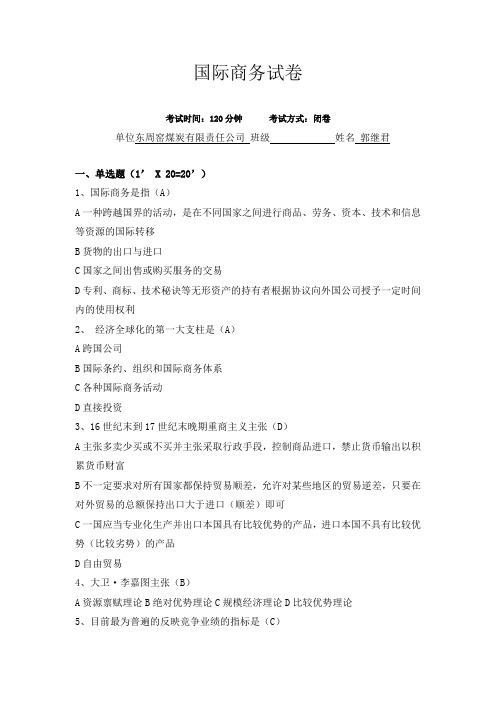
国际商务试卷考试时间:120分钟考试方式:闭卷单位东周窑煤炭有限责任公司班级姓名郭继君一、单选题(1’ X 20=20’)1、国际商务是指(A)A一种跨越国界的活动,是在不同国家之间进行商品、劳务、资本、技术和信息等资源的国际转移B货物的出口与进口C国家之间出售或购买服务的交易D专利、商标、技术秘诀等无形资产的持有者根据协议向外国公司授予一定时间内的使用权利2、经济全球化的第一大支柱是(A)A跨国公司B国际条约、组织和国际商务体系C各种国际商务活动D直接投资3、16世纪末到17世纪末晚期重商主义主张(D)A主张多卖少买或不买并主张采取行政手段,控制商品进口,禁止货币输出以积累货币财富B不一定要求对所有国家都保持贸易顺差,允许对某些地区的贸易逆差,只要在对外贸易的总额保持出口大于进口(顺差)即可C一国应当专业化生产并出口本国具有比较优势的产品,进口本国不具有比较优势(比较劣势)的产品D自由贸易4、大卫·李嘉图主张(B)A资源禀赋理论B绝对优势理论C规模经济理论D比较优势理论5、目前最为普遍的反映竞争业绩的指标是(C)A市场份额与利润特性B竞争优势C市场地位D企业内部特定资源6、关于大宗贸易市场及其竞争特点说法正确的是(D)A规模经济效益 B是地方性而不是全球性的C经验曲线的效应非常明显 D是一个真正的全球性市场7、贸易进入是指(C)A投资者通过对与股权投资有直接联系的技术等各种资源的控制而从中获利B企业将国内生产和加工的产品输往海外目标市场的活动C通过购买、参与当地企业的股份,直接在海外从事生产、销售和其他经营活动的投资形式D许让方向受许方转让技术、商标、统一的经营方法等,让受许方在本企业的监督与帮助下,利用本企业形象和品牌经营本企业的特定业务8、效率导向型投资动机是指(B)A企业为寻求稳定的资源供应和利用廉价资源而进行的对外直接投资B以追求利润最大化为目标C指企业进行对外直接投资的目的在于降低成本,提高生产效率D将投资分散于不同的国家和产业,以便安全稳妥地获得较高的利润9、对外直接投资的形式中属于收购进入的弊端的是(A)A受原有契约关系的限制B各方对企业的控制权和管理权的争夺C各方矛盾与摩擦较多D迅速进入东道国市场,从而可缩短投资回收年限10、市场细分的客观基础是(B)A消费者需求的相似性 B消费者需求的差异性C政府政策 D市场潜力11、目标市场的评价方中,反映国际企业投资的赢利状况而且是事前评价与选择经营地点的重要标准的是(A)A投资收益比较的分析B数量分析C表格分析法D国家(地区)吸引力一企业优势矩阵12、存在大量商品和劳务的提供者(卖方)和顾客(买方),各种资源禀赋与信息可以自由流动,个别卖方和买方的需求与供给变化对市场价格的影响可以忽略不计的是(D)A寡头垄断B完全垄断市场C不完全竞争市场D完全竞争市场13、宏观政治风险是指(B)A由有选择地影响某个领域投资和经营活动的行动或事件所造成,构成某些行业或企业特有的风险B由于各种政治因素使东道国的经营环境发生了超过某种程度的变化,对企业的国际经营带来不利影响的可能性C那些广泛而全面地影响在一国的所有外国投资或经营的全局性政治事件或政府行为所引起D采用渐进方式,通过控制和限制逐步削弱外资公司所有者的控制14、没收,是指(B)A东道国政府在将外国企业在该国的投资收归国有时以某种方式给予一定的补偿B指东道国政府根据自己的主权,采用强制措施无偿地把外资企业或外资在合资企业中的股份收归国有C采用渐进方式,通过控制和限制逐步削弱外资公司所有者的控制的过程D东道国为促进国际收支的平衡,可能会制定某种政策对境内所有企业的外汇收支加以控制15、文化的主要功能不包括(C)A导向功能B协调功能C约束功能D交流功能16、世界贸易组织的组织结构中,最高权力机构是(A)A总理事会B理事会C委员会D部长会议17、下列属于国际商品渗透模式中多元化经营模式的是(C)A企业以面向国内市场的现有产品直接转向出口,以满足与国内用户具有相同需求的海外市场需要B厂商为了更好地满足与国内市场有同样需求的海外市场需要,将现有产品进行大幅度的改动或开发出新的产品加以出口C企业根据自己获取的国际市场信息,结合本企业所具有的生产技术和管理经验,针对不同市场特点生产和出口不同产品D厂商将面向国内市场的现有产品输往海外,以开发与国内需求不大相同的海外市场18、商品包装策划中,多种包装策略是指(B)A一个企业所生产的各种不同产品,在包装上采用相同的造型、图案、色彩或其他相同的特征,使消费者很容易发现是同一家企业的产品B当企业经营的各种产品质量存在着较大差别时,企业对不同档次、不同质量、不同等级的产品分别采用不同的包装,而对质量水平相近的产品采用一种包装C把在使用时有关联的几种商品,纳入一个包装内,同时出售,使消费者购买一次就可以满足多种需求,为消费者提供较多的方便D原包装的商品用完后,包装物可再利用19、国际定价策略中成本导向定价法是指(D)A是一种以成本回收为基础的顺算定价法B以市场需求为基础,根据消费者承受的消费价格为依据C是一种以相同产品的价格来定价的方法D以强化本企业产品市场竞争能力为目标来决定出口商品价格水平的一种定价方法20、关于成本导向定价法中收支平衡定价法正确的是(C)A产品价格=单位产品成本 X(1+利润加成)B每增加一件产品所增加的单位可变成本C产品价格=(总固定成本+目标利润)/生产能力(销售量)+单位变动成本D以市场需求为基础,根据消费者承受的消费价格为依据二、多选(2’ X 15=30’)1、国际商务的形式有(AB)A国际商品贸易B国际服务贸易C国际技术许可和特许经营D国际间接投资2、经济全球化的具体表现形式有(ABCD)A生产全球化B贸易全球化C服务全球化D市场国际化3、规模经济的表现形式有(AC)A规模经济贸易模型B马歇尔外部经济C产品生命周期理论D张伯伦内部规模经济4、产品生命周期理论把产品的贸易过程划分为(ABCD)A萌芽期B初始期C成长期D成熟期5、全球行业市场及其竞争特点有(ACD)A规模经济效益B合作竞争C经验曲线的效应D整体、全方位竞争6、“波特四因素”模型中认为影响企业开发其竞争优势最大、最直接的有(ABD)A生产要素B需求情况C相关产业以及企业组织D战略和竞争程度7、企业三种基本竞争模式包括(ABD)A成本领先B差别化C销售渠道创新D专一化8、国际市场进入模式中非股权安排进入的形式有(ABCD)A技术许可B特许经营C管理合同D服务合同9、目标市场应具备的条件(ABCD)A市场较成熟B有一定的规模和发展潜力C竞争者未完全控制D符合企业目标和能力10、西方经济学理论将市场区分为(ABCD)A完全竞争市场B完全垄断市场C不完全竞争市场D寡头垄断11、PEST分析包括(BCD)A贸易分析B政治分析C经济分析D社会文化分析12、政治风险三个显著的特点包括(BCD)A历史性B不可预测性C非市场力D涉及面广、影响时间长13、世界贸易组织在今天经济生活中作用包括(BCD)A主持继续谈判B贸易政策评审机制发挥重要作用C向国际收支发生困难的成员国提供必要的贷款D争端解决机制的良好运行维护了多边贸易体制的权威14、下列各项中属于国际商品渗透模式的有(ABCD)A市场渗透模式B技术开发C产品开发模式D市场开发模式15出口商品价格上调的原因包括(BCD)A产品供过于求,而改进产品、增加促销手段或其他可供选择的措施又不见成效B企业为了适应经营战略调整的需要而调高出口商品价格C出口企业为了适应经营环境变化而进行的价格调整D企业在受到外部限制的情况下所采取的一种不得已的价格调整行为三、判断(1’X10=10’)1、国际间接投资即证券投资,是指企业购买外国公司的上市股票或外国公司、政府发行的债券等(×)2、小岛清的国际生产折衷理论认为外国直接投资的两个基本必要条件是国外生产成本比国内生产成本低,和跨国公司的生产成本比当地企业低(√)3、多国市场的特点有“国际竞争规模是全球性而不是地方性的”(√)4、差别化是指某一战略商务单位所提供的产品和服务具有与其竞争对手相区别的特征和个性(√)5、合资经营的企业从法律上讲是一个独立的法人,它具有起诉和应诉的能力(√)6、市场定位的方法中特色定位法是指通过对顾客欲望和需求寻找利益切入点进行产品定位(×)7、一体化技术,是指采取各种措施使跨国公司在东道国的子公司尽可能地与当地经济实现—体化,其目的在于帮助子公司尽量成为东道国经济的一分子(×)8、共同市场是指成员国之间完全取消关税或其他贸易壁垒,并且对非成员国实行统一的关税率而缔结的同盟(×)9、市场渗透模式是指厂商为了更好地满足与国内市场有同样需求的海外市场需要,将现有产品进行大幅度的改动或开发出新的产品加以出口(×)10、促销即促进销售,是指企业运用各种手段,传递产品或劳务信息,以说服和激励顾客购买企业的产品或劳务,实现扩大销售目的的一切企业活动的总和(√)四、简答(10’X2=20’)1、何谓“波特四因素”模型?是分析国际竞争优势的工具,迈克尔波特认为影响一个国家某一个行业国际竞争优势有以下六点:生产要素、需求状况、相关及支持产业、企业战略、结构和同业竞争、政府、机会2、何谓竞争优势判别法?竞争优势判别法是一个企业或国家在某些方面比其他的企业或国家更能带来利润或效益的优势,源于技术、管理、品牌、劳动力成本等。
《国际商务》复习题
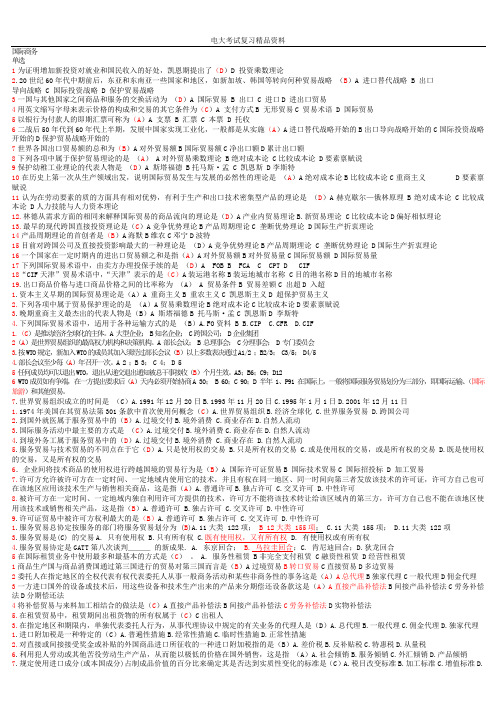
国际商务单选1为证明增加新投资对就业和国民收入的好处,凯恩期提出了(D)D 投资乘数理论2.20世纪60年代中期前后,东亚和东南亚一些国家和地区,如新加坡、韩国等转向何种贸易战略(B)A 进口替代战略 B 出口导向战略 C 国际投资战略 D 保护贸易战略3一国与其他国家之间商品和服务的交换活动为(D)A 国际贸易 B 出口 C 进口D 进出口贸易4用英文缩写字母来表示价格的构成和交易的其它条件为(C)A 支付方式B 无形贸易C 贸易术语 D 国际贸易5以银行为付款人的即期汇票可称为(A)A 支票 B 汇票 C 本票 D 托收6二战后50年代到60年代上半期,发展中国家实现工业化,一般都是从实施(A)A进口替代战略开始的B出口导向战略开始的C国际投资战略开始的D保护贸易战略开始的7世界各国出口贸易额的总和为(B)A对外贸易额B国际贸易额C净出口额D累计出口额8下列各项中属于保护贸易理论的是(A) A对外贸易乘数理论 B绝对成本论 C比较成本论 D要素禀赋说9保护幼稚工业理论的代表人物是(D)A 斯塔福德 B托马斯·孟 C 凯恩斯 D李斯特10在历史上第一次从生产领域出发,说明国际贸易发生与发展的必然性的理论是(A)A绝对成本论B比较成本论C重商主义 D要素禀赋说11认为在劳动要素的质的方面具有相对优势,有利于生产和出口技术密集型产品的理论是(D)A赫克歇尔—俄林原理 B绝对成本论 C比较成本论 D人力技能与人力资本理论12.林德从需求方面的相同来解释国际贸易的商品流向的理论是(D)A产业内贸易理论B.新贸易理论 C比较成本论D偏好相似理论13.最早的现代跨国直接投资理论是(C)A竞争优势理论B产品周期理论C 垄断优势理论 D国际生产折衷理论14产品周期理论的首创者是(B)A海默B维农C邓宁D波特15目前对跨国公司及直接投资影响最大的一种理论是(D)A竞争优势理论B产品周期理论 C 垄断优势理论 D国际生产折衷理论16一个国家在一定时期内的进出口贸易额之和是指(A)A对外贸易额B对外贸易量C国际贸易额 D国际贸易量17下列国际贸易术语中,由卖方办理投保手续的是(D)A FOB B FCA C CPT D CIF18“CIF天津”贸易术语中,“天津”表示的是(C)A装运港名称B装运地城市名称 C目的港名称D目的地城市名称19.出口商品价格与进口商品价格之间的比率称为(A) A 贸易条件B 贸易差额C 出超D 入超1.资本主义早期的国际贸易理论是(A)A 重商主义B 重农主义C 凯恩斯主义D 超保护贸易主义2.下列各项中属于贸易保护理论的是(A)A贸易乘数理论B绝对成本论C比较成本论D要素禀赋说3.晚期重商主义最杰出的代表人物是(B)A 斯塔福德B 托马斯·孟C 凯恩斯D 李斯特4.下列国际贸易术语中,适用于各种运输方式的是(B)A.FO资料 B B.CIP C.CFR D.CIF1.(C)是推动经济全球化的主体。
国际商务期末考试题及答案

国际商务期末考试题及答案一、选择题(每题2分,共20分)1. 国际商务是指:A. 国内贸易B. 跨国贸易C. 国际贸易D. 国际投资2. 跨国公司通常是指:A. 拥有海外子公司的公司B. 只在本国运营的公司C. 只做出口贸易的公司D. 只做进口贸易的公司3. 国际商务中,以下哪个不是文化差异的影响因素?A. 语言B. 宗教C. 教育水平D. 法律体系4. 国际商务中,以下哪个不是贸易壁垒?A. 关税B. 配额C. 反倾销税D. 国际货币基金组织(IMF)5. 以下哪个不是国际商务谈判的特点?A. 需要考虑文化差异B. 需要考虑法律法规C. 只关注价格因素D. 需要考虑政治风险6. 国际商务中,以下哪个不是风险管理的策略?A. 风险规避B. 风险转移C. 风险接受D. 风险增加7. 国际商务中,以下哪个不是市场进入策略?A. 出口B. 合资C. 独资D. 进口8. 国际商务中,以下哪个不是国际支付方式?A. 信用证B. 汇票C. 支票D. 现金交易9. 国际商务中,以下哪个不是国际物流的特点?A. 跨国性B. 复杂性C. 单一性D. 时效性10. 国际商务中,以下哪个不是国际市场营销的策略?A. 产品策略B. 价格策略C. 渠道策略D. 质量策略二、简答题(每题10分,共30分)1. 简述国际商务与国内商务的主要区别。
2. 描述国际商务谈判中文化差异对谈判的影响。
3. 解释什么是国际市场营销的4P策略。
三、案例分析题(每题25分,共50分)1. 假设你是一家跨国公司的市场部经理,公司计划进入一个新的国际市场。
请分析并提出你的市场进入策略,并解释你的选择。
2. 某国际公司在海外运营时遇到了当地政府的贸易壁垒,导致产品无法顺利进入市场。
请分析可能的解决方案,并提出你的建议。
国际商务期末考试答案一、选择题1. C2. A3. C4. D5. C6. D7. D8. D9. C10. D二、简答题1. 国际商务与国内商务的主要区别在于国际商务涉及跨国界,需要考虑不同国家的法律法规、文化差异、政治风险以及汇率变动等因素。
单招国际商务笔试题及答案
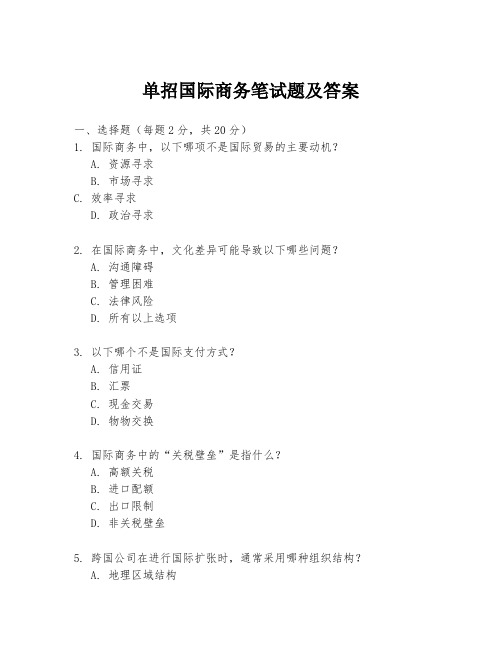
单招国际商务笔试题及答案一、选择题(每题2分,共20分)1. 国际商务中,以下哪项不是国际贸易的主要动机?A. 资源寻求B. 市场寻求C. 效率寻求D. 政治寻求2. 在国际商务中,文化差异可能导致以下哪些问题?A. 沟通障碍B. 管理困难C. 法律风险D. 所有以上选项3. 以下哪个不是国际支付方式?A. 信用证B. 汇票C. 现金交易D. 物物交换4. 国际商务中的“关税壁垒”是指什么?A. 高额关税B. 进口配额C. 出口限制D. 非关税壁垒5. 跨国公司在进行国际扩张时,通常采用哪种组织结构?A. 地理区域结构B. 产品部门结构C. 客户群体结构D. 混合结构6. 以下哪项不是国际市场营销的策略?A. 标准化B. 适应化C. 本土化D. 集中化7. 国际商务谈判中,以下哪种行为被视为不礼貌?A. 准时到达B. 穿着得体C. 打断对方讲话D. 准备充分8. 国际商务中的“转移定价”通常用于什么目的?A. 减少税收负担B. 增加利润C. 规避风险D. 提高市场份额9. 在国际商务中,以下哪个因素与政治风险无关?A. 政府稳定性B. 法律制度C. 经济政策D. 技术发展10. 以下哪个不是国际商务中的汇率风险管理策略?A. 期货合约B. 期权合约C. 远期合约D. 长期贷款二、简答题(每题10分,共30分)11. 简述国际商务中的全球化与多国化的区别。
12. 描述国际商务中的文化冲突及其解决策略。
13. 解释国际商务中的“三角贸易”概念及其对现代商务的影响。
三、案例分析题(每题25分,共50分)14. 假设你是一家跨国公司的市场部经理,你的公司计划进入一个新的国际市场。
请分析在进入该市场前需要考虑的主要因素,并提出一个市场进入策略。
15. 阅读以下案例:一家公司在海外设立了子公司,但由于不了解当地的商业习惯和法律,导致了一系列的问题。
请分析该公司可能面临的挑战,并提出相应的解决方案。
答案:一、选择题1. D2. D3. D4. C5. D6. D7. C8. A9. D10. D二、简答题11. 全球化是指企业在全球范围内进行标准化的运营,追求规模经济和市场效率,而多国化则是指企业在不同国家采取不同的运营策略,以适应当地市场的需求和文化差异。
国际商务英语复习题库.
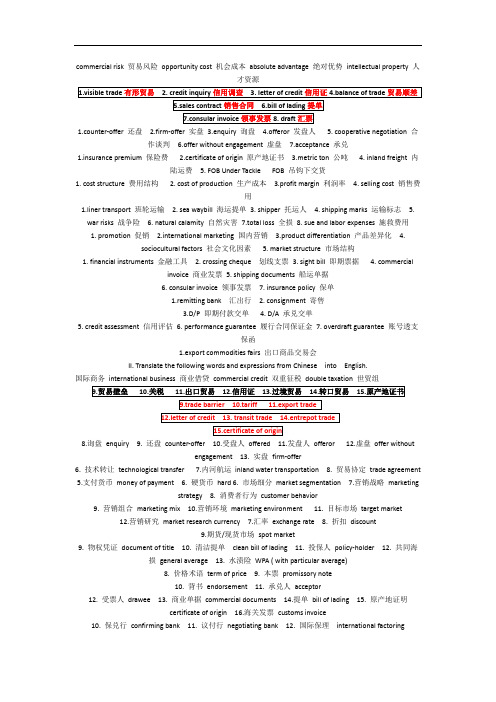
commercial risk 贸易风险opportunity cost 机会成本absolute advantage 绝对优势intellectual property 人才资源1.counter-offer 还盘2.firm-offer 实盘3.enquiry 询盘4.offeror 发盘人5. cooperative negotiation 合作谈判 6.offer without engagement 虚盘7.acceptance 承兑1.insurance premium 保险费2.certificate of origin 原产地证书3.metric ton 公吨4. inland freight 内陆运费 5. FOB Under Tackle FOB 吊钩下交货1. cost structure 费用结构2. cost of production 生产成本3.profit margin 利润率4. selling cost 销售费用1.liner transport 班轮运输2. sea waybill 海运提单3. shipper 托运人4. shipping marks 运输标志5.war risks 战争险 6. natural calamity 自然灾害7.total loss 全损8. sue and labor expenses 施救费用1. promotion 促销2.international marketing 国内营销3.product differentiation 产品差异化4.sociocultural factors 社会文化因素 5. market structure 市场结构1. financial instruments 金融工具2. crossing cheque 划线支票3. sight bill 即期票据4. commercialinvoice 商业发票5. shipping documents 船运单据6. consular invoice 领事发票7. insurance policy 保单1.remitting bank 汇出行2. consignment 寄售3.D/P 即期付款交单4. D/A 承兑交单5. credit assessment 信用评估6. performance guarantee 履行合同保证金7. overdraft guarantee 账号透支保函1.export commodities fairs 出口商品交易会II. Translate the following words and expressions from Chinese into English.国际商务international business 商业借贷commercial credit 双重征税double taxation 世贸组8.询盘enquiry 9. 还盘counter-offer 10.受盘人offered 11.发盘人offeror 12.虚盘offer withoutengagement 13. 实盘firm-offer6. 技术转让technological transfer7.内河航运inland water transportation8. 贸易协定trade agreement 5.支付货币money of payment 6. 硬货币hard 6. 市场细分market segmentation 7.营销战略marketingstrategy 8. 消费者行为customer behavior9. 营销组合marketing mix 10.营销环境marketing environment 11. 目标市场target market12.营销研究market research currency 7.汇率exchange rate 8. 折扣discount9.期货/现货市场spot market9. 物权凭证document of title 10. 清洁提单clean bill of lading 11. 投保人policy-holder 12. 共同海损general average 13. 水渍险WPA ( with particular average)8. 价格术语term of price 9. 本票promissory note10. 背书endorsement 11. 承兑人acceptor12. 受票人drawee 13. 商业单据commercial documents 14.提单bill of lading 15. 原产地证明certificate of origin 16.海关发票customs invoice10. 保兑行confirming bank 11. 议付行negotiating bank 12. 国际保理international factoring(1) budget a. an arrangement by which a monopoly producer or owner gives another permission for theexclusive right to manufacture or sell the products in a certain area(2) return b. money paid to the owner of a copyright for permission to publish copy right material and to the owner of a patent for permission to use a patented design, usu. at an agreed percentage of the selling price of theproduct(3) portfolio c a special right to an inventor to be the only person to make and sell, or to authorize others tomake and sell a newly-invented machine or process(4) royalty d. all forms of man-made obstructions to international trade other than tariffs, includingprohibitions and quotas, etc.(5) expertise e. the entire collection of investments in the form of stocks, bonds, or certificate of deposits forpurposes other than controlling(6) licensor f. one in which one of the parties agrees to supply, at the contract price, a complete product readyfor use, such as a new home, factory, ship, etc(7) patent g. an account of probable future income and expenditure during a stated period, usu. a year used asa guide in making financial arrangements(8) non-tariff barrier h. the gain from an investment, either as income or yield or as profit on the sale of theinvestment(9) turnkey contract i. expert knowledge or skill, esp. in a particular field; know-how(10) franchise j. a person or company granting a licence答案:1 g 2 h 3e 4b 5i 6j 7c 8d 9f 10a21 affiliate a. the total annual income of a state22. assets b. distribute the administrative powers over a less concentrated area23. world company c. to bring under the control or ownership of a nation24.facilities d something that is put in business operation25. revenue e. well-being26. decentralize f. organization structure27.nationalize g. something designed, built or installed to serve a specific function or perform a particularservice28. welfare h. a subsidiary company controlled by another29. framework i. a multinational whose national identity has been blurred30. input j. total resources of a business, as cash, accounts receivable, real estates etc.1h 2j 3i 4g 5a 6b 7c 8e 9f 10d21.service a. to restrict one's economic activities to certain particular fields22.abundant b. to develop the use of , make the best use of23. specialization c. something done to help or benefit others24. primary d. relating to the power of the immediate understanding of something without reasoning or study25.incentive e. a natural gift or ability26. alternative f. that which incites, rouses or encourages a person27. intuitive g. producing a desired or satisfactory result; able to perform duties well28.efficient h. plentiful, more than enough29.endowment i. that may be had, used etc. in place of sth. else30.exploit j. those commodities not processed, or only slightly processed, usually farm produce or rawmaterials1c 2h 3a 4j 5f 6i 7d 8g 9e 10b21. drawback a. to make prominent; to draw special attention22. highlight b. duties imposed on goods imported and exported23. bulky c. done by one side or party only24.perishable d. duties levied on the basis of the price of the goods25. tariff e. taking a lot of space, and often of shape difficult to handle26. specific duties f. money sent by post27. ad valorem duties g. duties levied on the basis of quantity, weight, size etc. of the goods28. unilaterally h. easily to go bad29. maritime i. duties paid on imported goods that are refunded when reexported30. remittance j. connected with the sea or navigation1i 2a 3e 4h 5b 6g 7d 8c 9j 10f21. business line a. an agreement setting forth the binding obligations of the relevant parties22. voluntary offer b. the main body of a contract23. contract c. absolutely necessary24. indispensable d. an offer made on the initiative of the offerer25. contract proper e. the party to whom an offer is made26. contracting parties f. a contract made by the buyer27. force majeure g. signatories of an agreement28.purchase contract h. an offer whose terms and conditions are binding on the offerer29.firm offer i. social or natural calamities that take place beyond the control of a contracting party30. offeree j. goods dealt in by a company1j 2d 3a 4c 5b 6g 7i 8f 9h 10e21.insured a.a payment demanded in accordance with an insurance policy22.premium b, a person who carries on insurance as a business23.potential loss c. something given or received as an equivalent for loss24. viability d. a combination of funds formed for common advantage25. claim e. the using up of goods and services having an exchangeable value26.margin f. loss which is possible to incur27.underwriter g. the amount paid by an insured for coverage under the contract28.consumption h. a person covered by an insurance policypensation i. ability to succeed in operation30.pooling j. amount above what is estimated as necessary1h 2g 3f 4i 5a 6j 7b 8e 9c 10d21.purchasing power a. to take what is needed from, to exploit22. assess b. purchasing power parity23.spur c. considerable desire to make purchase for consumption24.average d. a person or an organization etc. that receives something25. productive e. of person, the public, having the money to buy goods and services26. tap f. of an ordinary, common or usual kind in quality or amount27. infrastructure g. to urge or encourage28. recipient h. producing in high efficiency or in large quantity29. consumerism i. to judge an amount or value30. ppp j. large-scale public services, such as water and power supplies, road, rail and radio communications, etc.needed to support economic activity, esp. industry, trade and commerce1e 2i 3g 4f 5h 6a 7j 8d 9c 10b21.debtor a. the person who issues a draft, usually the exporter22. default b. irregular movement of ( prices, exchange rates etc.)23.dubious c. the sending of money or the money sent24.draft d. financially satisfactory25. remittance e. an unconditional order to someone to pay a sum of money26. fluctuation f. doubtful, uncertain, questionable27. drawer g. a person who owes money28. sound h. prohibit, forbid29. ban i. the person to whom a draft is drawn30. drawee j. fail to carry out an obligation1g 2j 3f 4e 5c 6b 7a 8d 9h 10i21. peg a. the stock of gold coin and bullion ( gold bars ) held by a note-issuing bank in a country on the goldstandard22.redeem b, to repay or pay off, esp. loan stock, debentures and preference shares or stock23. settlement c. the act of a government in reducing by law the exchange value of its currency in units of goldor as compared with other currencies24. exchange rate d. to keep fixed or unchanged25. fluctuations e. the price at which one currency can be exchanged for another currency26. gold reserves f. equal in value, on the same level27. money g. the act of paying a bill, debt, charge, etc.28. devaluation h. money in the hands of the public and being used to pay for goods and services29. offset i. upward and down ward movements in the economic system30. par j. to set one value against another or as equal to another1d 2b 3g 4e 5i 6a 7h 8c 9j 10f21.quota a. company expansion through the purchase of other business22. VER b. certain non-tangible assets held, principally covering the areas of patent protection, registered trademarks and designs, and copy-right23. acquisition c. a period of time during which tax is not levied24. synergy d. a way by which a place esp. property, can be reached or entered or used25. rebate e. the gain form an investment, either as income or yield or as profit in the sale of the investment26. intellectual property f. benefits from combining different businesses, normally claimed by the promoters ofmergers27. tax holiday g. reduce28. return h. a business where the provision of risk capital is shared between two or more firms29.access i. a limit placed by a government on the amount of imports or commodity30. joint venture j. an agreement by a country's exporters or government to limit their exports to anothercountry1i 2j 3a 4f 5g 6b 7c 8e 9d 10hIV. Make brief explanations of the following terms or give the full name of the abbreviation in34.Incoterms is abbreviation for International Rules for the Interpretation of Trade Terms 国际贸易术语解释通则P21(卷二)35. A packing list is a document made out by the seller stating the detailed content of eachindividual shipment.P33 (卷三)IV. Make brief explanations of the following terms or give the full name of the abbreviation inEnglish.31.positional bargaining is based on fixed, opposing viewpoints and tends to result inIV. Make brief explanations of the following terms or give the full name of the abbreviation inEnglish.FOB--- free on board (d port of shipment)CIF---P83 cost, insurance and freight (d port of destination) 成本加保险费加运费(指定目的港)CIP--- P89 carriage and insurance paid to (d place of destination)运费,保险费付至IV. Make brief explanations of the following terms or give the full name of the abbreviation inIV. Make brief explanations of the following terms or give the full name of the abbreviation inEnglish.31.UNCTAD is abbreviation for United Nations Conference on Trade and Development 联合国贸易和发展会议P27payee:P218 the payee (beneficiary) is a person who is addressed to receive the remittance.collection order P229 the collection order is a standard form of authority that enables the exporter to include specific instructions to his bank regarding the documentary collection(跟单托收).V. Answer the following questions in English.37. What are six commonly used trade terms?P86-89FOB, CIF, CFR, FCA, CPT, CIPV. Answer the following questions in English.36. What does "price" mean?P111Price is the amount of money that is needed to acquire some combination of a product and itsaccompanying services.V. Answer the following questions in English.35 What are the most commonly used payment methods in international settlement? P216The most commonly used payment methods in international settlement are remittance, collection, letter of credit, factoring, letter of guarantee and stand-by credit.36. What is remitting bank? P218Remitting bank is the bank transferring funds at the request of a remitter to its correspondent or its branch in another country and instructing the latter to pay a certain amount of money to abeneficiary.37. What are the major items of a collection order(托收委托书)?P229-230The major items of a collection order are as follows:name and address of the drawee, name and address of the remitting bank as well as the collecting bank, documents release conditions, store and insure clause, bank and other charges, protest clause, advise of dishonor, prior presentation, case-of-need. method of settlement,subject to URC, the signature of the draweeV. Answer the following questions in English.36.what should a successful business letter of establishing business relations contain?P262A successful business letter of establishing business relations should contain the following: the source of his information, his intention, the business scope of his firm and also its branches and liaison offices, if any, the reference as to his firm's financial position and integrityVI. Translate the following into Chinese.40.In the second half of the twentieth century, international business has become an important economic force. Today few, if any, countries are economically self-sufficient. Even China, with its vast human and natural resources, has not been able to remain aloof from the world economy. In the United States, international business touch people's lives daily. Common goods and services such as Shell gasoline stations, etc., often identified with the United States, are, in fact, foreign。
成人高等教育国际商务英语复习题及答案

20. Managers set _____and decide how their company can achieve them.
29. The letter of credit should be established ____ its clauses ____ conformity with the terms and conditions of the contract.
A. in, in B. in, with C.on, with D. with, in ABCD 正确答案: D
A.may accept B.accept C.must accept D. can accept ABCD 正确答案: B
33. After unpacking the case we found the goods did not____with the original sample.
pare B. match C.agree D.measure ABCD 正确答案: B
17. Taking into consideration our long-standing business relations with you, we accept ___by D/P.
A. inquires B.payment C.installment D. counter-offer ABCD 正确答案: B
18. When the seller receives the buyer ’ s counter-offer, and he finds some terms and conditions unacceptable to him, he will state his own opinions in a letter, which is called as _____。
- 1、下载文档前请自行甄别文档内容的完整性,平台不提供额外的编辑、内容补充、找答案等附加服务。
- 2、"仅部分预览"的文档,不可在线预览部分如存在完整性等问题,可反馈申请退款(可完整预览的文档不适用该条件!)。
- 3、如文档侵犯您的权益,请联系客服反馈,我们会尽快为您处理(人工客服工作时间:9:00-18:30)。
国际商务复习题国际商务客观题复习题1..A (n) ____ marketing strategy that views the world's consumers as similar in their tastes and preferences is consistent with the mass production of a standardized output.A) domestic B) globalC) indigenous(本土的) D) national2.Examples of _______ include Coca-Cola and Pepsi, Ford and Toyota, Boeing and Airbus, and Caterpillar and Komatsu.A) service goods B) homogeneous productsC) global competition D) market integration3.Globalization results in a greater degree of __________ across markets than would be present otherwise.A) diversification B) diversityC) homogeneity D) heterogeneity (异质性)4. Aircraft manufacturers like Boeing, Airbus, and Lockheed-Martin export goods and services to consumers in other countries. This practice is referred to as:A) international trade B) country-to-country exchangeC) global salesmanship D) cross-national barter5. A firm's decision to invest resources in business activities outside its home country is referred to as:A) international diversification B) foreign direct investmentC) cross-national investment D) transnational commerce6. Under the umbrella of GATT, there have been eight rounds of negotiations among member states. The most recent round of negotiations was referred to as the:A) North Atlantic Round B) Doha RoundC) Uruguay Round D) Singapore Round7. Among developing nations, __________ has received the greatest volume of inward FDI in recent years.A) Indonesia B) ChinaC) India D) South Korea8. A __________ is any business that has productive activities in two or more countries.A) multinational enterprise B) international conglomerateC) international consortium D) g lobal endeavor9. Every country has a political, economic, and legal system. Collectively we refer to these systems as constituting the __________ economy of a country.A) civic B) publicC) administrative D) political10. In the early 20th century, the socialist ideology spit into two broad camps. The __________ believed that socialism could be achieved only through violent revolution and totalitarian dictatorship, while the __________ committed themselves to achieving socialism by democratic means and turned their backs on violent revolution and dictatorships.A) individualists, collectivists B) social democrats, communistsC) collectivists, individualists D) communists, social democrats11. The four broad types of economic systems are:A) market economy, collective economy, production economy, and political economyB) market economy, command economy, mixed economy, and state-directed economyC) collective economy, production economy, mixed economy, and politically-controlled economyD) market economy, production economy, politically-controlled economy, and command economy12.A situation in which a country specializes in producing the goods it produces most efficiently and buys the products it produces less efficiently from other countries, even if it could produce the good more efficiently itself is referred to as:A)comprehensive advantage B) pertinent advantageC)comparative advantage D) absolute advantage13.To an even greater degree than the theory of absolute advantage, the theory of __________ suggests that tradeis a positive-sum game in which all gain.A) Total advantage B) mercantilismC) comparative advantage D)paradoxical advantage14. In a pure __________ economy all productive activities are privately owned, as opposed to being owed by the state.A) command B) state-directed C) mixed D) market15.One of the most famous examples of a(n) __________ is the limitation on auto exports to the United States enforced by Japanese automobile producers in 1981.A) involuntary import restraint B) voluntary export restraintC) trade reconciliation D) referred export restraint1-5:BCCAB 6-10:BBADD 10-15:BCCDB1. The term culture refers to an organization's ________.A)compensation systems B)norms and value systems C) standing among its peer firmsD)policies, rules, and regulations2. The two main components of globalization are_____________________A) the globalization of markets and the globalization of productionB) the globalization of finance and the globalization of accountingC) the globalization of advertising and the globalization of servicesD) the standardization of technology and the globalization of markets3. In a pure command economy, the goods and services that a country produces, the quantity in which they are produced, and the prices at which they are sold are all planned by________________A) private industry B) individual entrepreneurs C) local trade associations D) the government4. Every country has a political, economic, and legal system. Collectively we refer to these systems as constituting the __________ economy of a country.A) civic B) public C) administrative D) political5. Research has long maintained that a major factor of success for new products is the closeness of the relationship betweenA) finance and marketing. B) marketing and R&D. C) f inance and materials management. D)operations and R&D.6. Both import quotas and VERs benefit ______ by limiting import competition, but they result in higher prices, which hurtsA) domestic producers, consumers B) governments, consumersC) consumers, foreign producers D) foreign producers, governments7. In a pure __________ economy all productive activities are privately owned, as opposed to being owed by the state.A)mixed B) command C) market D) production8. A situation in which a country specializes in producing the goods it produces most efficiently and buys the products it produces less efficiently from other countries, even if it could produce the good more efficiently itself is referred to as: _________A) comprehensive advantage B) pertinent advantage C) comparative advantage D)absolute advantage9. Tariffs fall into two categories. These are_______________A) statutory tariffs and punitive tariffs B) specific tariffs and ad valorem tariffsC) general tariffs and specific tariffs D) fixed tariffs and civil tariffs10. The term __________ refers to a system that stresses the primacy of collective goals over individual goals.A) individualism B) democracy C) collectivism D) capitalism11. Ricardo's theory of comparative advantage suggests that consumers in all nations can consume more if there are ___________A) trade restrictions on services only. B) no trade restrictions.C)severe trade restrictions. D) trade restrictions on manufactured goods only.12. Which of the following markets has experienced the highest degree of globalization?A) industrial goods and materials B)services C) consumer products D) i ntellectual capital13. Host –country costs arise from possible adverse effects on competition within the host nation ,adverse effects on the balance of payments, and ______.A)resource –transter effects B)economic growth C)capital markets D) loss of autonomy14. From _____________,we can explain Japan do well in the automobile industry, and Switzerland excel in the production and export of precision instruments and pharmaceuticals.A) new trade theory B) product life-cycle theory C) comparative advantage D) porter’s theory15.According to _______, subsidies can help a firm achieve a first-mover advantage in an emerging industry.A) strategic trade policy B) antidumping policies C) consumers D) importers1-5:BADDB 6-10:ACCBC 11-15:BADDA1. In his 1817 book entitled Principles of Political Economy, _______ introduced the theory of comparative advantage. A)Adam Smith B)David Ricardo C)Raymond Vernon D) Max Weber2. There are many determinates of culture except____________.A) social structure B)education C) religion D) technology3. The last major communist power left in the world is___________A) Hungry B) Brazil C) China D) India4. To an even greater degree than the theory of absolute advantage, the theory of __________ suggests that trade is a positive-sum game in which all gain.A) total advantage B) mercantilism C) comparative advantage D) paradoxical advantage5. The term corporate culture refers to an organization's ________.A) compensation systems B) norms and value systemsC) standing among its peer firms D) policies, rules, and regulations6. Vernon propose the product life-cycle theory in the mid-1960s which suppose a new product is developed in______at the beginning.A)united states B)England C) China D)Japan7. Which one is not the benefit of host-country?A) resource transfer effects B)employment effects C)balance of payments D)national sovereignty and autonomy8. There are three main types of legal systems in use around the world :common law, civil law ,and _______A) theocratic law B)contract law C) united nations convention D) private action9.A (n) ____ marketing strategy that views the world's consumers as similar in their tastes and preferences is consistent with the mass production of a standardized output.A) domestic B) global C) indigenous D) national10.Examples of _______ include Coca-Cola and Pepsi, Ford and Toyota, Boeing and Airbus, and Caterpillar and Komatsu.A) service goods B) homogeneous products C) global competition D) marketintegration11.Globalization results in a greater degree of __________ across markets than would be present otherwise.A) diversification B) diversity C) homogeneity D) h eterogeneity12. Aircraft manufacturers like Boeing, Airbus, and Lockheed-Martin export goods and services to consumers in other countries. This practice is referred to as:A) international trade B)country-to-country exchange C) global salesmanship D) cross-national barter13. A firm's decision to invest resources in business activities outside its home country is referred to as:A) international diversification B)foreign direct investment C)cross-national investmentD)transnational commerce14. Under the umbrella of GATT, there have been eight rounds of negotiations among member states. The most recent round of negotiations was referred to as the:A) North Atlantic Round B) Uruguay Round C) Pacific-Basin Round D) Singapore Round15. Among developing nations, __________ has received the greatest volume of inward FDI in recent years.A) Indonesia B) China C) India D) South Korea1-5:BCCAB 6-10:BBBDC 11-15:CBADA。
